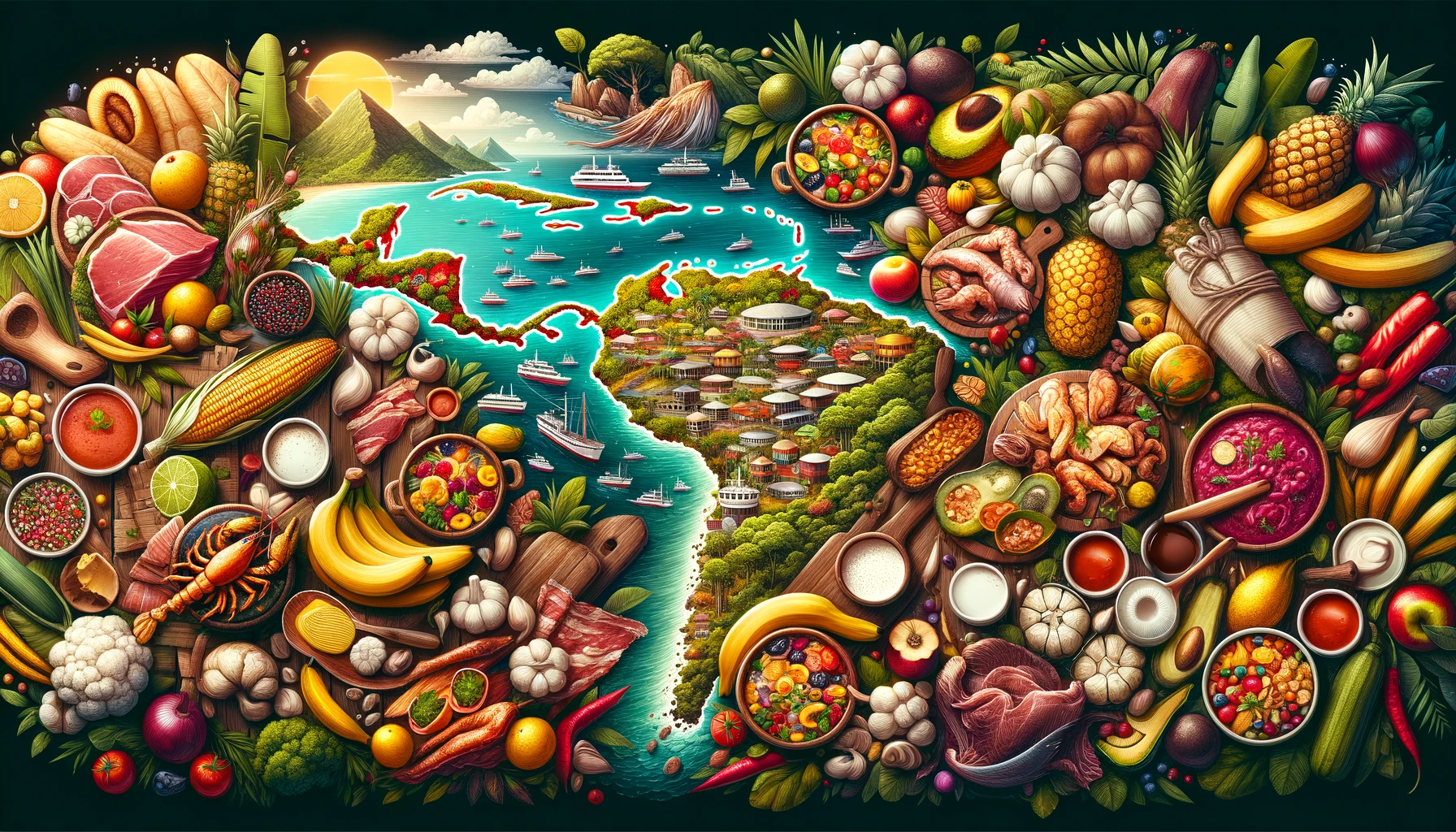Take Me to The Recipes
Venezuela, a gem located on the northern coast of South America. Like Venezuelan Cuisine the country is blessed with a diverse range of attractions, ranging from tropical beaches to snow-capped Andean peaks.
Its breathtaking scenery includes the majestic Angel Falls, the world’s highest uninterrupted waterfall, and the expansive plains of Los Llanos. The nation’s main industrial activities revolve around oil and petroleum, making it one of the world’s major oil exporters.
With a population of approximately 28 million people, Venezuela is a melting pot of cultures, and this diversity is beautifully reflected in its rich culinary traditions, particularly its Venezuelan cuisine.
Venezuelan Cuisine – Key Takeaways
- Rich blend of indigenous, African, and European influences.
- Emphasis on fresh, local ingredients.
- Famous for its savory arepas and sweet treats like quesillo.
- Diverse range of dishes, from starters to main courses and desserts.
- A reflection of Venezuela’s cultural and geographical diversity.
- A must-try for every food enthusiast.
Take Me to The Recipes
More Articles to Read
- North and South American Cuisine – A Culinary Expedition
- Europe Cuisine: Savor the Continent’s Best Culinary Secrets!
- African Cuisine: Discover the Bold Flavors & Global Charm!
- Asian Cuisine Unlock its Secrets – Taste, Health & Global Influence!
Where is Venezuela?

Venezuela is a country in South America, bordering the Caribbean Sea and the North Atlantic Ocean, between Colombia and Guyana. It is situated on major sea and air routes linking North and South America.

Index to Contents
- Take Me to The Recipes
- Facts about Venezuela
- The History of Venezuela and the Impact it has had on the Food
- How Venezuela‘s Climate and Geography has Influenced Venezuelan Cuisine
- Understanding the Essence of Venezuelan Cuisine
- Venezuelan Culinary Traditions
- How Healthy is Venezuelan Food?
- The Most Popular Venezuelan Food
- Great Recipes to Try at Home
- Conclusion
- FAQ’s
Savor iconic Venezuelan Cuisine Food Recipes – Click on each tantalizing picture to open up the Recipe
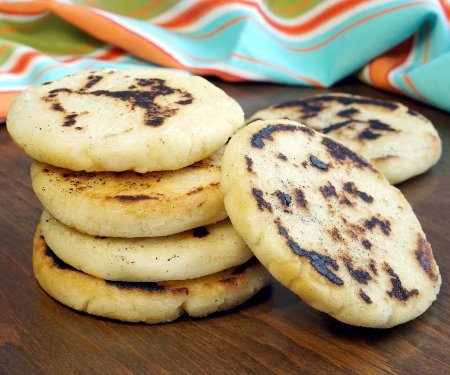




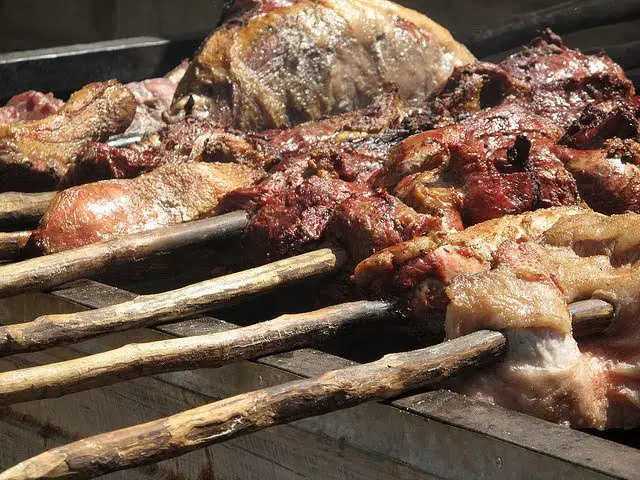

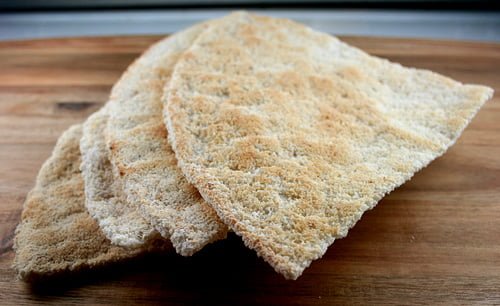
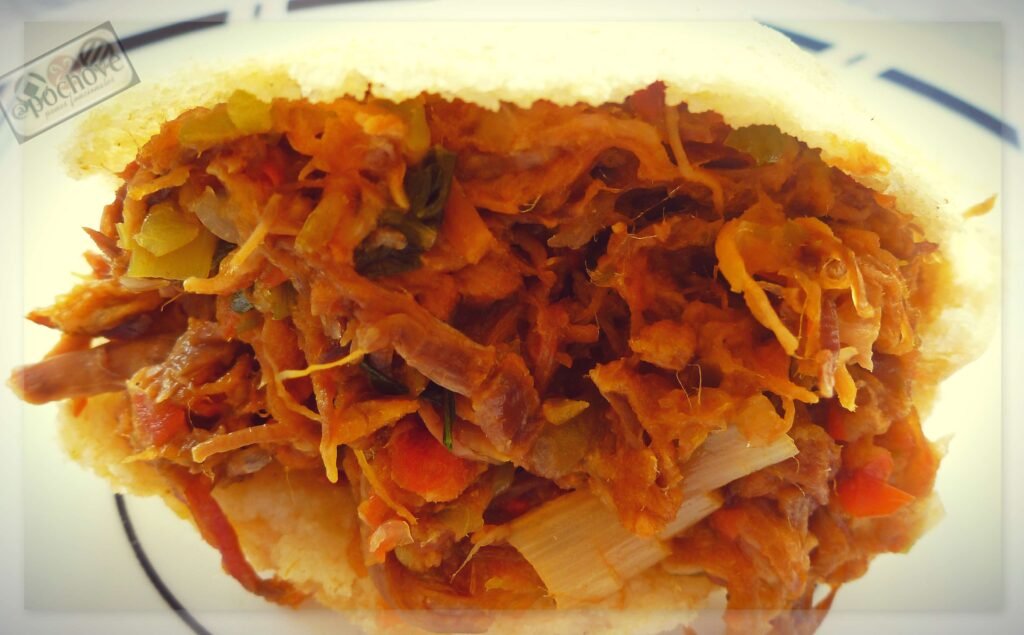
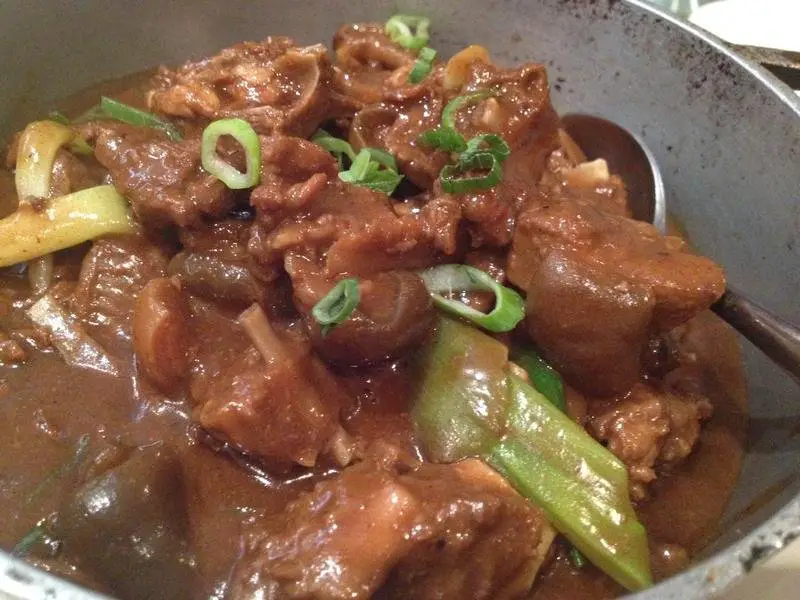
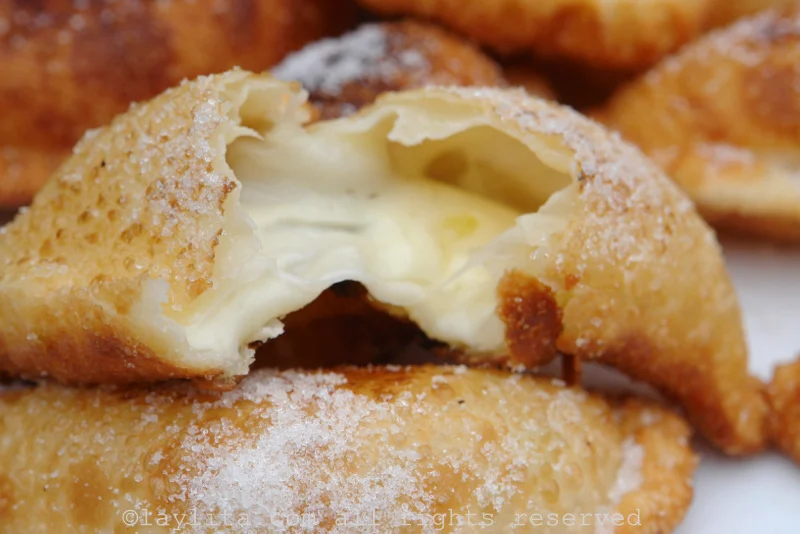

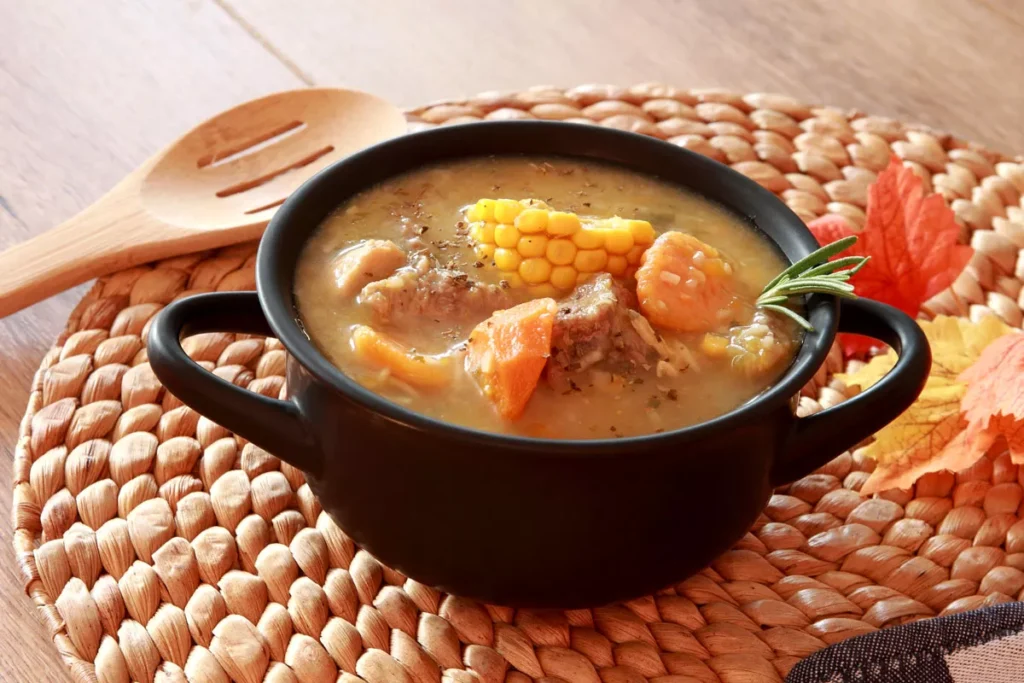
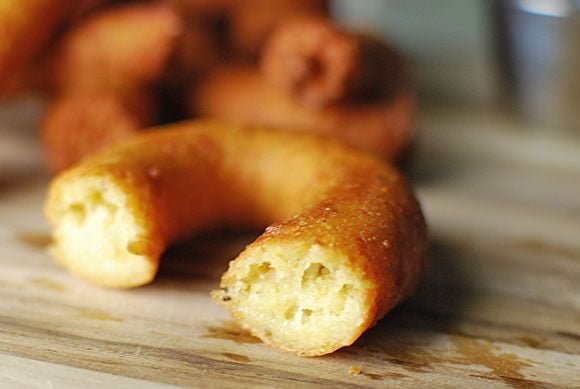
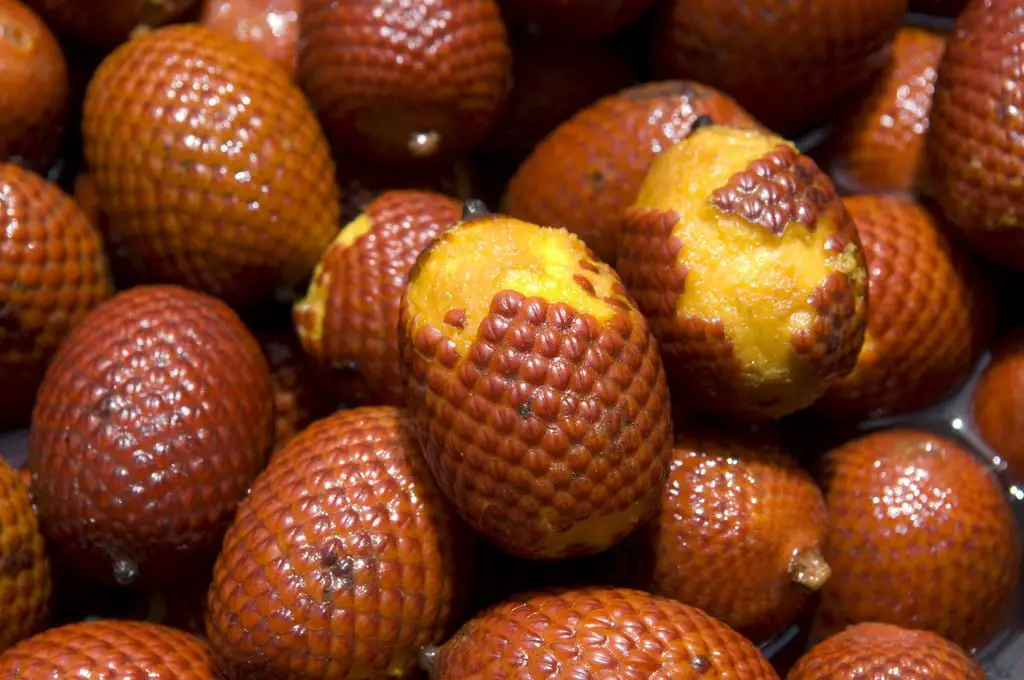
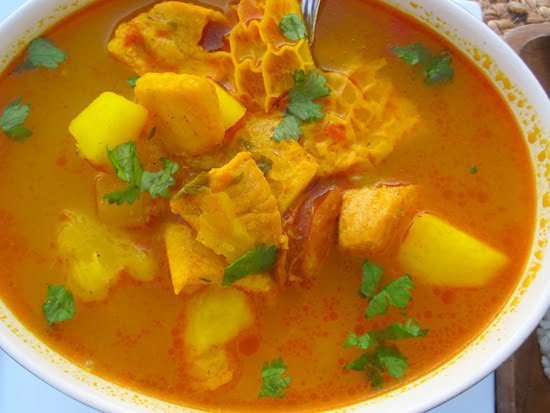

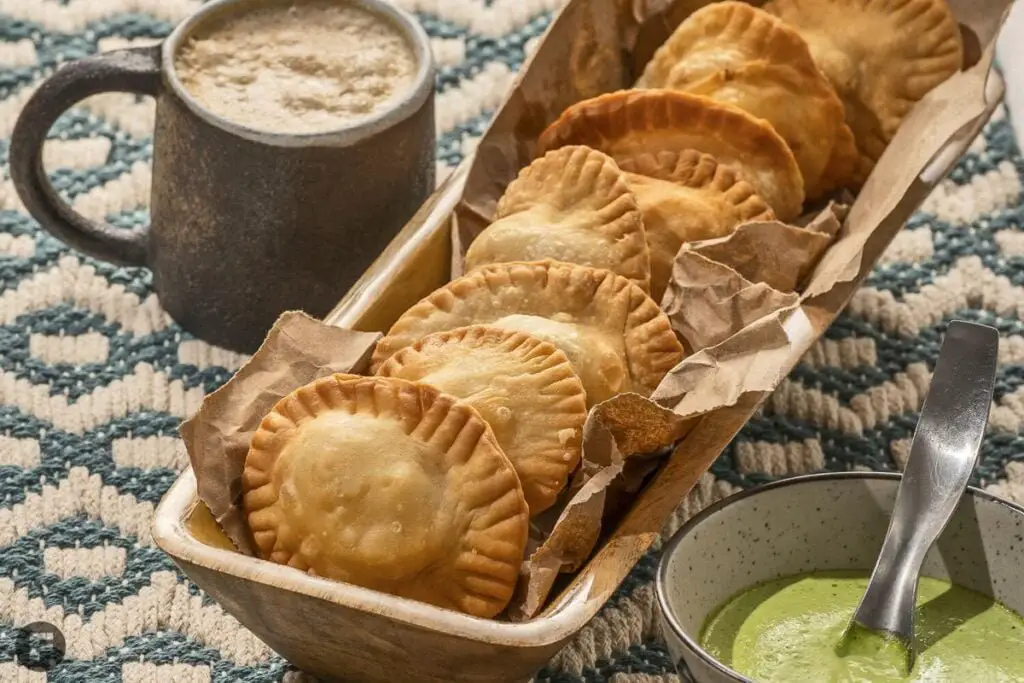
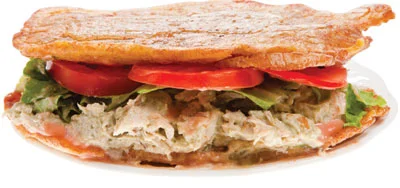

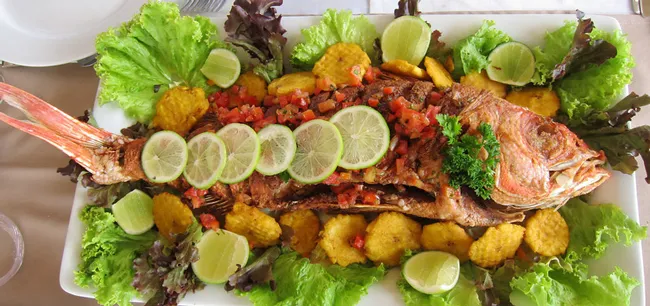



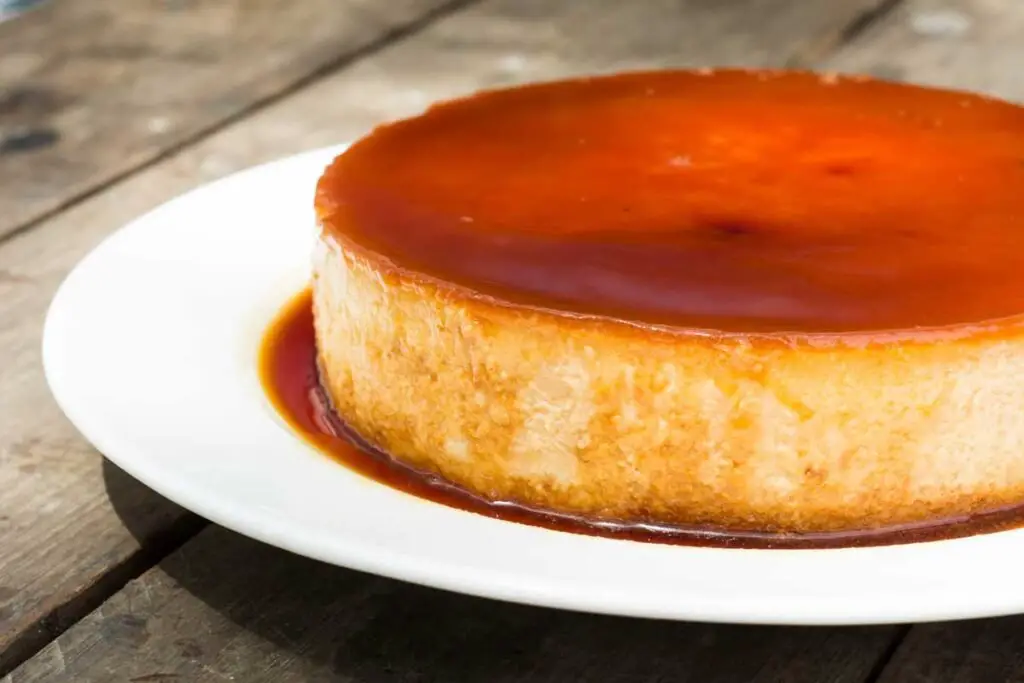
Facts about Venezuela
Before Europeans started setting up shop, Venezuela was home to the Carib, Arawak, and Chibcha peoples. People have been living in Venezuela for more than 10,000 years – that’s a lot of history! (Source: Britannica)
Christopher Columbus
Now, let’s dive into some key moments. In 1498, Christopher Columbus, the explorer guy, landed in what we now call Venezuela. Fun fact: European folks started calling the place “Little Venice” during their adventures.
Fast forward to 1521 when the Spanish decided to make themselves at home in Venezuela. They stuck around, doing their thing, until 1810 when the people of Venezuela were like, “Hey, it’s time to break free!” That’s when they declared independence from Spain. It’s like Venezuela had its own coming-of-age moment in history. (Source: BBC News)
Venezuela is One of Three Countries Split from Gran Colombia
After the short-lived republic of Gran Colombia, created by the revolutionary Simón Bolívar from 1819 to 1830, fell apart, modern Venezuela emerged as one of the three countries formed in 1830.
Gran Colombia initially included the territories of present-day Colombia, Venezuela, Ecuador, and Panama, along with parts of northern Peru, western Guyana, and northwest Brazil. However, due to various reasons, including regional differences, the republic eventually dissolved, leading to the establishment of separate nations, including modern Venezuela.
(Source: Britannica)
Venezuela is Effectively a Dictatorship


Hugo Chavez was in office for 14 years. During this time he styled himself as a champion of the poor, investing billions of dollars of Venezuela’s oil wealth into social programs He died in 2013.
His nominated successor, Nicolás Maduro, took over from him and continues to rule today.
Although the ruling party, United Socialist Party, held sham elections since 2015 Maduro rules “By Decree.”
(Source: BBC News)
1/3rd of the Population is Malnourished

Venezuela has faced economic challenges and dealt with hyperinflation. According to a United Nations survey in 2020, around one-third of Venezuelans, which is approximately 9.3 million people, were reported to be experiencing insufficient access to food.
Source – Guardian
The Population is Declining
Due to the humanitarian crisis, over 4.5 million people have left Venezuela and moved abroad, causing a decrease in the country’s population.
Source – Guardian
Venezuela is Home to the World’s Tallest Waterfall

Venezuela boasts the world’s tallest waterfall known as Angel Falls. This natural wonder has an impressive height of 979 meters (3,212 feet) and a breathtaking drop of 807 meters (2,648 feet).
Source – Guiness Book of Records
Large Number of Gun Deaths
Venezuela has one of the highest rates of gun-related deaths globally. In 2016, it ranked as the 6th highest, placing it among six countries responsible for over 50% of the world’s firearm-related fatalities.
Venezuela Has one Of the Most Dangerous Roads in the World
It is home to some of the world’s most perilous roads, ranking 7th globally and holding the title for the most dangerous roads in South America.
The World’s largest Oil Reserves
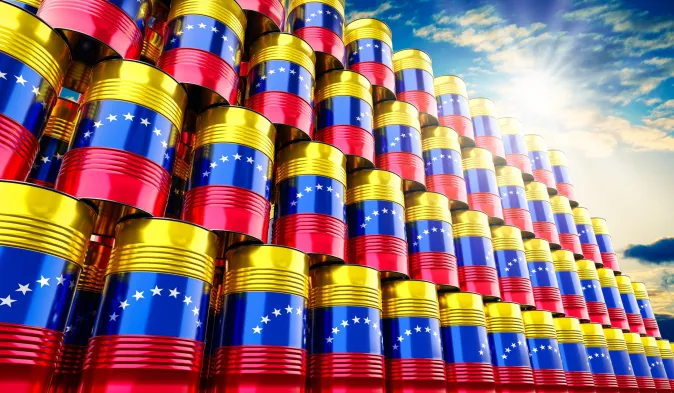
The country is believed to possess the world’s largest oil reserves, with a staggering 303.2 billion barrels, accounting for 17.9% of the global total. Additionally, the country is rich in resources such as coal, iron ore, and gold.
Venezuela Has the Most Lightning Strikes
Venezuela is home to the most electric place on Earth. At the junction of the Catatumbo River and Lake Maracaibo, lightning strikes up to 28 times per minute.
This phenomenon, known as the Beacon of Maracaibo, Catatumbo lightning, or the ‘everlasting storm,’ occurs an average of 260 days per year.
The History of Venezuela and the Impact it has had on the Food
The history of Venezuela and its food, is a rich and diverse one, influenced by the indigenous, European, African, and Caribbean cultures. Here is a brief overview of some of the main periods and their impact on the food:
Pre-Columbian period (before 1498)
The indigenous people of Venezuela relied on corn, beans, cassava, plantains, yams, and other crops as their main staples. They also hunted, fished, and gathered fruits, nuts, and honey. They developed techniques to process corn and cassava into flour, which they used to make arep.
as, casabe, and other breads. They also fermented corn and cassava to make drinks such as chicha and Masato.
Colonial period (1498-1810)
The arrival of the Spanish colonizers brought new ingredients, such as wheat, rice, sugar, coffee, cocoa, cheese, and meat, as well as new cooking methods, such as frying, baking, and stewing.
The colonizers also introduced African slaves, who contributed their own culinary traditions, such as the use of coconut, plantain, okra, and spices.
The fusion of these different cuisines resulted in dishes such as hallacas, a corn dough stuffed with meat, raisins, olives, and capers, wrapped in plantain leaves and boiled; pabellón criollo, a dish of rice, black beans, shredded beef, and fried plantains; and sancocho, a hearty soup of meat, vegetables, and tubers.
Independence period (1810-1830)

The struggle for independence from Spain was marked by political and social turmoil, as well as food scarcity and famine. Many people resorted to eating wild animals, such as armadillos, iguanas, and turtles, as well as insects, roots, and leaves.
Some dishes that emerged from this period are mondongo, a tripe soup; hervido, a chicken or beef soup with corn and vegetables; and pisillo, a shredded meat dish seasoned with onion, garlic, and peppers.
Modern period (1830-2000)
The modern history of Venezuela has been shaped by the discovery of oil, the rise and fall of dictatorships, the development of democracy, and the social and economic crises of recent years.
The food culture has also evolved, reflecting the diversity and creativity of the Venezuelan people. Some of the influences that have enriched the cuisine are the immigration of Italians,
Portuguese, Arabs, Chinese, and others; the exchange of products and recipes with neighboring countries, such as Colombia, Brazil, and the Caribbean islands; and the adaptation of international dishes, such as pizza, hamburgers, and sushi, to the local palate.
Some of the dishes that represent the modern Venezuelan cuisine are cachapas, corn pancakes filled with cheese; tequeños, cheese sticks wrapped in dough and fried; perico, scrambled eggs with onion, tomato, and cheese; and arepas rellenas, arepas stuffed with various fillings, such as chicken salad, ham and cheese, black beans and cheese, and beef and avocado.
Political Turmoil and Economic Challenges (1950–2000)

There have been frequent periods of political instability, economic crises, and social changes influenced food availability.
Sadly, this has Increased the reliance on imported foods due to economic challenges.
Traditional dishes like arepas, hallacas, and pabellón criollo remained staples, but some ingredients became scarcer.
Contemporary Period (2000–Present)
The ongoing economic challenges have led to food shortages and changes in eating habits.
There is Increased migration which has led to the spread of Venezuelan cuisine abroad.
Efforts to preserve traditional culinary practices continue while the country adapts to modern challenges.
References:
- Venezuelan cuisine – Wikipedia
- Venezuela’s Food History—Arepas, Hallacas y Más! – Familia Kitchen
- Culture of Venezuela
How Venezuela‘s Climate and Geography has Influenced Venezuelan Cuisine
Venezuela’s climate and geography have influenced its cuisine in various ways, such as:
The Coastal Regions

The coastal regions, which enjoy a tropical climate and abundant seafood, have developed dishes based on fish, shellfish, coconut, plantain, and citrus fruits. Some examples are pescado frito (fried fish), sopa de mariscos (seafood soup), and patacón (fried plantain sandwich)
The Andean Regions
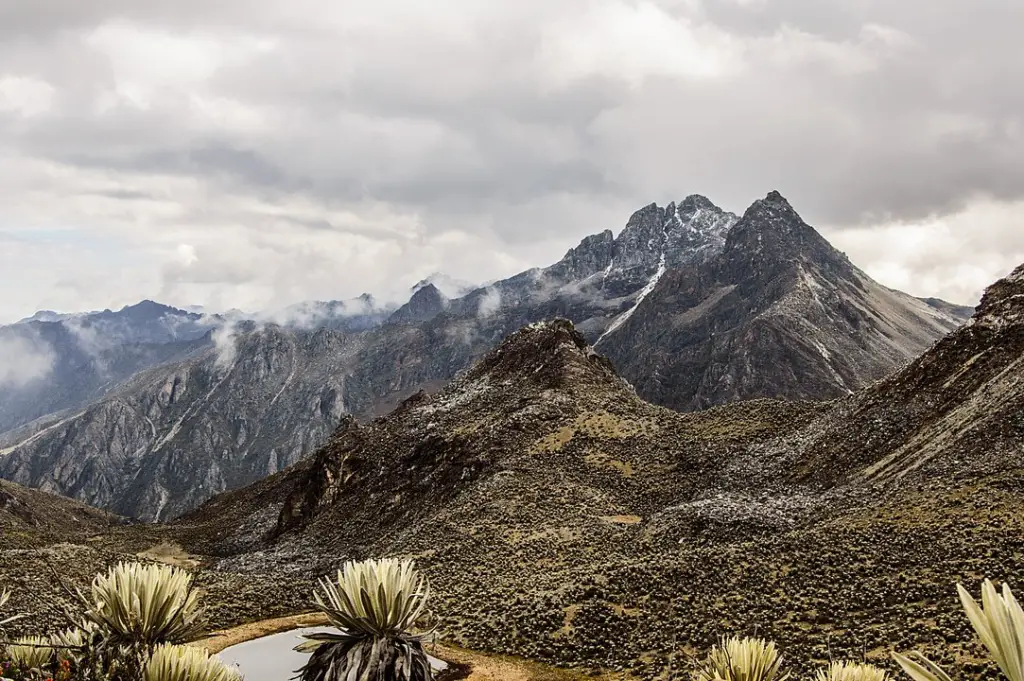
The Andean regions, which have a cooler and drier climate and fertile valleys, have cultivated crops such as potatoes, corn, wheat, barley, and quinoa, as well as dairy products and meat.
The Llanos
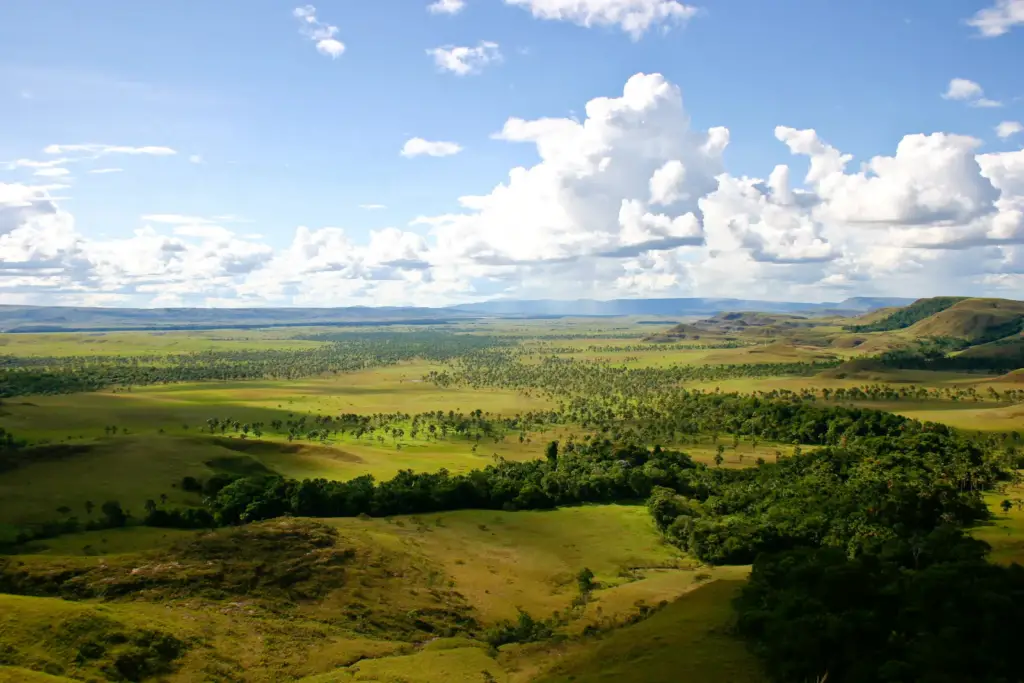
The Llanos, which are vast plains that experience seasonal flooding and drought, have developed a ranching culture based on cattle, horses, and wild game. Some examples are carne en vara (meat on a stick), carne mechada (shredded beef), and chigüire (capybara meat)
Guyana
Guyana region, which includes the Amazon rainforest and the tepuis, has a diverse and exotic flora and fauna, as well as indigenous influences. Some examples are casabe (cassava bread), moriche (a palm fruit), and curiara (a stew of turtle, monkey, or snake meat)

References:
- Venezuelan cuisine – Wikipedia
- Venezuela’s Food History—Arepas, Hallacas y Más! – Familia Kitchen
- Culture of Venezuela
Understanding the Essence of Venezuelan Cuisine
Venezuelan cuisine, a vibrant mosaic of flavors and techniques, offers a tantalizing journey through its rich history, diverse landscapes, and the heartwarming spirit of its people. It beautifully encapsulates the confluence of indigenous traditions, Spanish influences, African elements, and even some Italian, Portuguese, and French touches.
Central to understanding Venezuelan food is the concept of “sabor” (flavor) — a combination of fresh ingredients and time-tested methods, ensuring each dish tantalizes the palate. The cuisine, inherently communal, is built around shared meals, festive gatherings, and family recipes passed down through generations.
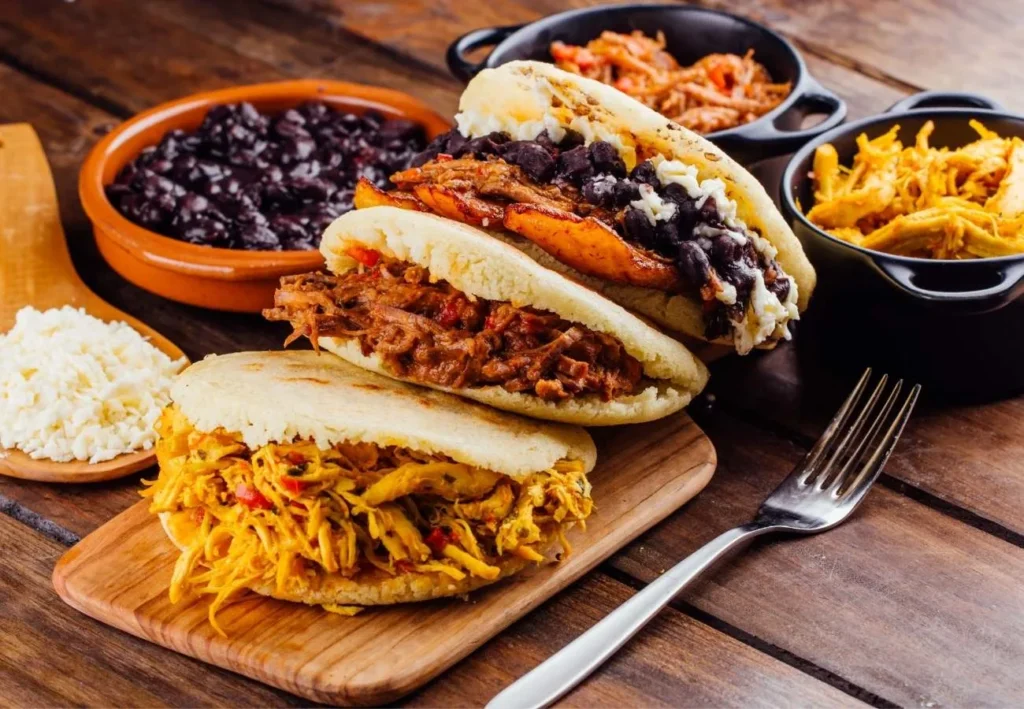
One cannot delve into Venezuelan culinary traditions without mentioning “arepas”, versatile cornmeal patties often stuffed with a myriad of fillings, from creamy cheeses to savory meats. They’re not just a staple food; they’re a symbol of Venezuelan identity.
The coastal bounty inspires dishes like “pabellón criollo”, a flavorful plate typically consisting of shredded beef, black beans, rice, and fried plantains. It’s a dish that tells a historical tale, with each component representing different parts of Venezuelan heritage.
The country’s tropical climate blesses it with an array of fruits, leading to refreshing drinks like “papelon con limon”, a blend of unrefined sugar cane juice and lemon, and delectable desserts like “quesillo”, a flan-like custard.
Yet, beyond the ingredients and recipes, the soul of Venezuelan cuisine rests in its celebratory nature. Festivals see the making of “hallacas”, corn dough parcels filled with a stew of meats and adorned with olives and capers, wrapped in banana leaves and steamed. This dish exemplifies the essence of Venezuelan festivities.
In its core, Venezuelan cuisine is a celebration — of its land, its diverse influences, and its people. It’s a delightful exploration of taste, texture, and tradition, offering a window into the country’s vibrant soul.
Venezuelan Culinary Traditions
Venezuela, a nation draped in tropical beauty and brimming with cultural diversity, offers a culinary heritage that is as vibrant as its landscapes. Its gastronomic traditions weave a rich tapestry of indigenous roots, Spanish colonial influences, African nuances, and even European infusions.
At the heart of Venezuelan cuisine is the beloved “arepa”. Made from ground maize dough or precooked cornmeal, these round, golden pockets are versatile delights, often filled with meats, cheeses, or avocados. They’re more than just food; they’re a daily ritual and a symbol of home.
Another iconic dish is “pabellón criollo”, often considered the national dish. This culinary masterpiece showcases shredded beef, black beans, white rice, and slices of ripe plantains. Each element, served side by side, beautifully embodies Venezuela’s multifaceted cultural heritage.
The coastal regions, with their bountiful seas, give rise to dishes like “cachapa”, a sweet corn pancake often paired with “queso de mano”, a soft, artisanal cheese. Meanwhile, the Andean region boasts traditional dishes like “pisca andina”, a warm chicken soup seasoned with coriander and speckled with potatoes.
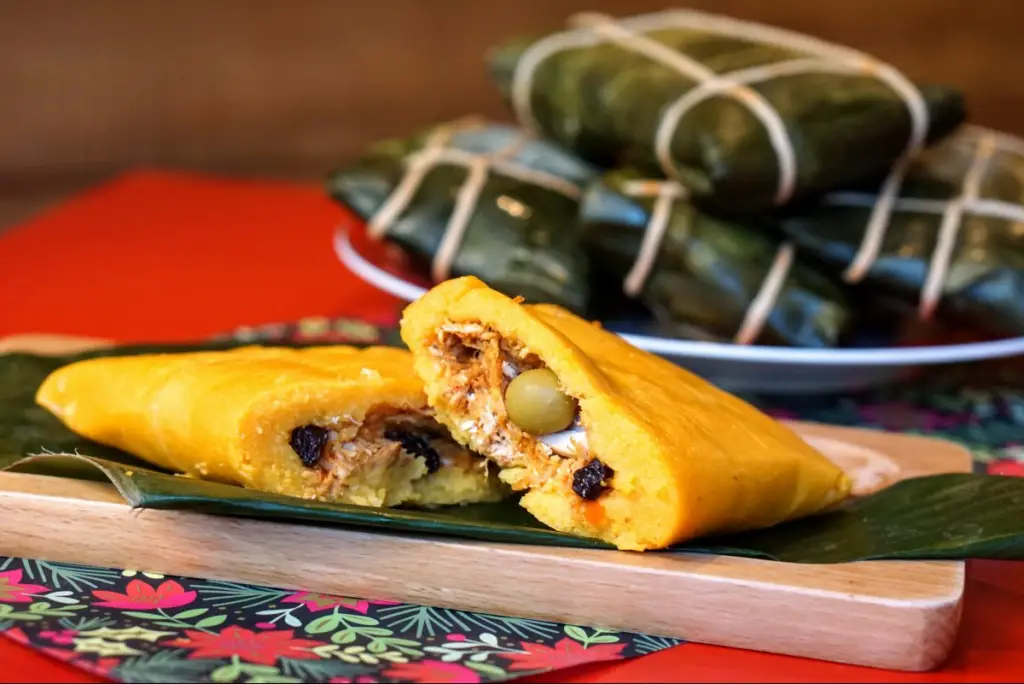
Festivities in Venezuela are incomplete without “hallacas”. Prepared especially during Christmas, these are corn dough parcels filled with a medley of meats, raisins, and capers, then wrapped in banana leaves and steamed. This labor-intensive dish is a testament to family gatherings and shared culinary endeavors.
Sweets too have a special place in Venezuelan hearts. “Dulce de leche”, a creamy caramel-like treat, and “golfeados”, sweet rolls swirled with sugar and cheese, often round off meals.
In essence, Venezuelan culinary traditions are a flavorful journey through its regions, histories, and celebrations. Every bite tells a tale of the past, evokes a memory, and kindles a sense of communal spirit and pride.
How Healthy is Venezuelan Food?

Venezuelan food is a mixture of different cuisines, such as indigenous, Spanish, African, and Caribbean, that reflect the country’s rich and diverse culture.
However, some of the traditional dishes may not be very healthy, as they are high in fat, salt, sugar, or refined carbohydrates. For example, arepas, cachapas, tequeños, and patacones are all made with fried dough or plantains, which can increase the risk of obesity, diabetes, and cardiovascular diseases.
Some of the healthier options are hallacas, which are boiled corn dough with meat and vegetables, sancocho, which is a soup of meat and tubers, and perico, which is scrambled eggs with onion, tomato, and cheese.
The health of the Venezuelan population has deteriorated significantly in the last decade, due to the political and economic crisis that has affected the availability and quality of food, water, sanitation, health care, and medicines.
According to the World Health Organization
- The life expectancy at birth in Venezuela has decreased from 74.1 years in 2000 to 73.9 years in 2019.
- The maternal mortality ratio has increased from 68 deaths per 100,000 live births in 2000 to 95 deaths per 100,000 live births in 2019.
- The country also faces outbreaks of infectious diseases, such as malaria, diphtheria, measles, and COVID-19, as well as chronic malnutrition, especially among children.
- The United Nations estimates that more than 5 million Venezuelans have fled the country since 2015, seeking better living conditions and access to basic services.
References
- Venezuelan cuisine – Wikipedia
- Venezuela (Bolivarian Republic of) – World Health Organization (WHO)
- Venezuela (Bolivarian Republic of) – World Health Organization
- Venezuela’s Health Sector: Current Crisis and Opportunities
- Continuing Venezuela exodus and COVID-19
The Most Popular Venezuelan Food

Venezuelan cuisine is diverse and flavorful, influenced by a mix of indigenous, European, African, and Caribbean culinary traditions. Here are some of the most popular Venezuelan dishes:
Arepa
Arepas are a staple in Venezuelan cuisine, made from ground maize dough and often filled with various ingredients like cheese, ham, or shredded beef.
Pabellón Criollo
A national dish, Pabellón Criollo consists of shredded beef, black beans, rice, and fried plantains. The combination of these elements represents the colors of the Venezuelan flag.
Cachapa
Cachapas are sweet corn pancakes served with cheese. They can be enjoyed as a snack or a breakfast item.
Hallaca
A traditional Christmas dish, Hallaca is a type of tamale made with corn dough and filled with a mixture of meats, olives, capers, and raisins, all wrapped in plantain leaves.
Tequeño
Tequeños are cheese-filled pastry sticks, often served as appetizers or snacks. They are commonly enjoyed at parties and social gatherings.
Asado Negro
Asado Negro is a slow-cooked beef dish with a rich, sweet, and savory flavor. It is often served with rice.
Empanadas
Venezuelan empanadas are deep-fried or baked pastries filled with various ingredients such as cheese, shredded beef, or black beans.
Mandoca
Mandoca is a sweet fried dough made with cornmeal, often served as a breakfast item and accompanied by cheese or jam.
Caraotas Negras
Black beans prepared with various seasonings, often served alongside rice. They are a common accompaniment to many Venezuelan dishes.
Chivo en Coco

Chivo en Coco is a dish featuring goat meat cooked in coconut milk, creating a rich and flavorful stew.
Quesillo
Quesillo is a Venezuelan version of flan, a creamy caramel dessert made with condensed milk, eggs, and sugar.
Perico
Perico is a traditional Venezuelan breakfast dish consisting of scrambled eggs with tomatoes, onions, and bell peppers.
These dishes showcase the diversity of Venezuelan cuisine, with a mix of flavors, textures, and cultural influences that make it unique and delicious.
Venezuelan – Great Recipes to Try at Home
Venezuelan cuisine is a delightful fusion of indigenous, African, and European culinary traditions. It emphasizes the use of fresh, locally sourced ingredients, resulting in dishes that are both flavorful and wholesome. From mouth-watering starters to hearty main courses and delectable desserts, Venezuelan food promises a gastronomic adventure like no other.
Venezuelan Food – Asado Negro (slow-cooked beef dish)

History and Background of Asado Negro:
Asado Negro, a beloved slow-cooked beef dish, originates from Venezuela and holds cultural significance in the country’s culinary heritage.
With African and European influences, this dish showcases the fusion of flavors and cooking techniques that have evolved over generations, making it a cherished part of Venezuelan gastronomy.
Venezuelan Food – Asado Negro Ingredients
- 2 lbs beef roast (such as chuck or round)
- 2 cups beef broth
- 1 cup red wine
- 1 cup brown sugar
- 1/2 cup soy sauce
- 1/2 cup vinegar
- 1/4 cup vegetable oil
- 1 onion, finely chopped
- 4 garlic cloves, minced
- 2 teaspoons ground black pepper
- 1 teaspoon ground cumin
- 1 teaspoon dried thyme
- Salt to taste
Venezuelan Food – Asado Negro Recipe
Marinating the Beef:
- Marinating Beef:
- Place the beef roast in a large bowl.
- In a separate bowl, mix together red wine, soy sauce, vinegar, brown sugar, garlic, black pepper, cumin, thyme, and salt.
- Pour the marinade over the beef, ensuring it’s well-coated.
- Cover and refrigerate for at least 4 hours or overnight.
Cooking the Asado Negro:
- Preheating Oven:
- Preheat the oven to 325°F (165°C).
- Searing the Beef:
- Heat vegetable oil in a large oven-safe pot.
- Remove the beef from the marinade, reserving the liquid.
- Sear the beef on all sides until browned.
- Preparing Braising Liquid:
- In the same pot, sauté chopped onions until golden.
- Pour in the reserved marinade and beef broth.
- Bring the liquid to a boil.
- Slow Cooking:
- Return the seared beef to the pot, ensuring it’s submerged in the liquid.
- Cover the pot and transfer it to the preheated oven.
- Slow-cook for approximately 3-4 hours or until the beef is tender and the sauce has thickened.
- Serving Asado Negro:
- Remove the pot from the oven.
- Slice the beef and serve it with the rich, flavorful sauce over rice or with traditional Venezuelan sides.
Serving Information:
- Serving Size: Approximately 4 people
- Estimated Cooking Time: 3-4 hours
- Calories: The total calorie count varies based on specific ingredients and portions. Please refer to nutritional information on product labels for accurate details.
Asado Negro captures the essence of Venezuelan cuisine, offering a delightful combination of slow-cooked beef infused with a savory-sweet marinade. Enjoyed as a special occasion dish or a comforting family meal, Asado Negro reflects the culinary diversity and cultural richness of Venezuela.
Venezuelan Food – Empanadas (Deep-fried or baked pastries)

History and Background of Empanadas:
Empanadas, a cherished dish in Venezuelan cuisine, have a rich history rooted in Spanish and Moorish influences. These savory pastries, with their flaky crusts and flavorful fillings, showcase the diverse culinary heritage of Venezuela.
Empanadas are enjoyed across the country and can be found at family gatherings, celebrations, and as popular street food.
Venezuelan Food – Empanadas Ingredients
Empanada Dough:
- 2 cups all-purpose flour
- 1/2 cup unsalted butter, cold and diced
- 1/2 cup water
- 1/2 teaspoon salt
- 1 egg (for egg wash)
Filling Options:
Choose one or create a variety:
- Shredded beef with spices
- Shredded chicken with onions and peppers
- Black beans and cheese
- Queso de mano (Venezuelan cheese) with ham
Venezuelan Food – Empanadas Recipe
Preparing the Dough:
- Making Empanada Dough:
- In a large bowl, combine flour and salt.
- Add cold, diced butter to the flour mixture and mix until it resembles coarse crumbs.
- Gradually add water, mixing until the dough comes together.
- Form the dough into a ball, cover with plastic wrap, and refrigerate for at least 30 minutes.
Filling the Empanadas:
- Preparing the Filling:
- Cook and prepare the chosen filling ingredients separately.
- Allow the filling to cool before assembling the empanadas.
Shaping and Filling Empanadas:
- Rolling Out the Dough:
- Preheat the oven to 375°F (190°C) if baking or prepare oil for frying.
- Roll out the chilled dough on a floured surface to about 1/8-inch thickness.
- Cutting and Filling:
- Use a round cutter or a small plate to cut out circles from the dough.
- Place a spoonful of the chosen filling in the center of each dough circle.
- Sealing and Shaping:
- Fold the dough over the filling, creating a half-moon shape.
- Seal the edges by pressing with a fork or crimping by hand.
- Baking or Frying:
- For baking: Place empanadas on a baking sheet, brush with beaten egg, and bake for 20-25 minutes or until golden brown.
- For frying: Heat oil in a pan, fry each empanada until golden on both sides, then drain on paper towels.
Serving Information:
- Serving Size: Approximately 6 empanadas per person
- Estimated Cooking Time: 30 minutes (excluding filling preparation)
- Calories: The total calorie count varies based on specific ingredients and portions. Please refer to nutritional information on product labels for accurate details.
Empanadas, with their golden, crispy crust and delicious fillings, are a delightful culinary tradition that brings people together in Venezuela. Whether enjoyed as a snack, appetizer, or part of a festive meal, empanadas embody the warmth and flavor of Venezuelan culture.
Venezuelan Food – Mandoca (sweet fried dough made with cornmeal)

History and Background of Mandoca:
Mandoca, a delightful sweet fried dough made with cornmeal, is a cherished treat in Venezuelan cuisine. Originating from the country’s rich culinary tapestry, mandoca reflects the diverse influences of Indigenous, African, and European traditions.
This beloved snack is often enjoyed with a cup of coffee or hot chocolate, making it a popular choice for breakfast or as a comforting snack throughout the day.
Venezuelan Food – Mandoca Ingredients
- 2 cups pre-cooked cornmeal (masarepa)
- 1 cup all-purpose flour
- 1/2 cup sugar
- 1/2 teaspoon salt
- 1 teaspoon baking powder
- 1 ripe banana, mashed
- 1/2 cup grated coconut
- 1 cup warm water
- Vegetable oil (for frying)
Venezuelan Food – Mandoca Recipe
Mixing the Dough:
- Combining Dry Ingredients:
- In a large bowl, mix pre-cooked cornmeal, all-purpose flour, sugar, salt, and baking powder.
- Adding Wet Ingredients:
- Add the mashed banana, grated coconut, and warm water to the dry ingredients.
- Mix well until a soft, uniform dough is formed.
Shaping and Frying Mandoca:
- Shaping Mandoca:
- Take small portions of the dough and shape them into flattened rounds or oval shapes.
- Frying Mandoca:
- Heat vegetable oil in a deep pan or fryer to around 350°F (175°C).
- Carefully place the shaped mandoca into the hot oil, frying until golden brown on both sides.
- Draining and Cooling:
- Once fried, use a slotted spoon to remove the mandoca from the oil.
- Place them on paper towels to drain excess oil and cool.
Serving Information:
- Serving Size: Approximately 4 mandocas per person
- Estimated Cooking Time: 15-20 minutes
- Calories: The total calorie count varies based on specific ingredients and portions. Please refer to nutritional information on product labels for accurate details.
Mandoca’s crispy exterior and tender inside, combined with the natural sweetness from banana and coconut, create a delightful flavor that captures the essence of Venezuelan comfort food. Enjoyed by people of all ages, mandoca adds a touch of warmth and tradition to daily snacks in Venezuela.
Venezuelan Food – Caraotas Negras (Black beans prepared with various seasonings)
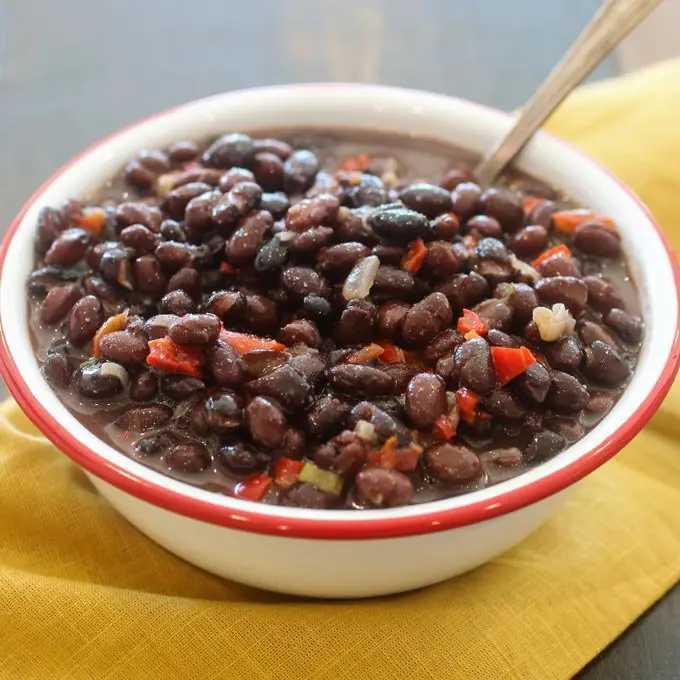
History and Background of Caraotas Negras:
Caraotas Negras, a staple in Venezuelan cuisine, are black beans prepared with various seasonings, reflecting the country’s diverse culinary heritage. This dish has Indigenous, African, and European influences, contributing to its rich and savory flavor profile.
Often served as a side dish or as the main component of a meal, Caraotas Negras showcase the importance of beans in Venezuelan gastronomy.
Venezuelan Food – Caraotas Negras Ingredients
- 2 cups black beans, dried
- 1 onion, finely chopped
- 1 bell pepper, diced
- 2 cloves garlic, minced
- 2 tablespoons vegetable oil
- 1 teaspoon cumin
- 1 teaspoon oregano
- Salt and pepper to taste
- 6 cups water (for soaking)
- 8 cups water (for cooking)
Venezuelan Food – Caraotas Negras Recipe
Preparing the Beans:
- Soaking the Beans:
- Rinse the dried black beans thoroughly.
- In a large bowl, soak the beans in 6 cups of water overnight or for at least 8 hours.
- Cooking the Beans:
- Drain and rinse the soaked beans.
- In a pot, add 8 cups of water and the soaked beans.
- Bring to a boil, then reduce heat to simmer and cook for about 1.5 to 2 hours or until beans are tender.
Seasoning the Caraotas Negras:
- Sauteing Aromatics:
- In a separate pan, heat vegetable oil over medium heat.
- Saute chopped onions, diced bell pepper, and minced garlic until softened.
- Adding Seasonings:
- Stir in cumin, oregano, salt, and pepper to the sauteed aromatics.
- Mix well to combine the seasonings.
- Combining with Beans:
- Add the seasoned aromatics to the cooked black beans.
- Simmer the mixture for an additional 15-20 minutes to allow flavors to meld.
Serving Information:
- Serving Size: Approximately 1 cup per person (as a side dish)
- Estimated Cooking Time: 2.5 to 3 hours
- Calories: The total calorie count varies based on specific ingredients and portions. Please refer to nutritional information on product labels for accurate details.
Caraotas Negras, with their hearty and aromatic blend, offer a taste of Venezuela’s culinary diversity. Whether served alongside rice or as part of a traditional Venezuelan meal, this dish represents the comforting and nourishing qualities that beans bring to the country’s gastronomic tapestry.
Venezuelan Food – Chivo en Coco (goat meat cooked in coconut milk)

History and Background of Chivo en Coco:
Chivo en Coco, a savory delight in Venezuelan cuisine, showcases the country’s diverse culinary influences with a touch of Caribbean flair. This dish features goat meat slow-cooked in creamy coconut milk, creating a unique blend of flavors that captures the essence of both Indigenous and Afro-Caribbean culinary traditions.
Popular in coastal regions, Chivo en Coco reflects the bounty of Venezuela’s natural resources and the creativity of its culinary heritage.
Venezuelan Food – Chivo en Coco Ingredients
- 2 pounds goat meat, cubed
- 2 cups coconut milk
- 1 onion, finely chopped
- 2 bell peppers, diced
- 3 cloves garlic, minced
- 2 tablespoons vegetable oil
- 1 teaspoon cumin
- 1 teaspoon paprika
- Salt and pepper to taste
- Fresh cilantro for garnish
Venezuelan Food – Chivo en Coco Recipe
Preparing the Goat Meat:
- Marinating the Meat:
- In a bowl, season the goat meat with cumin, paprika, salt, and pepper.
- Allow the meat to marinate for at least 30 minutes.
- Searing the Meat:
- In a large pot, heat vegetable oil over medium-high heat.
- Sear the marinated goat meat until browned on all sides.
Cooking with Coconut Milk:
- Sauteing Aromatics:
- Add chopped onions, diced bell peppers, and minced garlic to the pot.
- Saute until the vegetables are softened.
- Simmering with Coconut Milk:
- Pour in the coconut milk, ensuring it covers the goat meat.
- Bring the mixture to a boil, then reduce heat to simmer.
- Slow-Cooking the Dish:
- Cover the pot and let the Chivo en Coco simmer for 2 to 2.5 hours, or until the goat meat is tender.
Serving Information:
- Serving Size: Approximately 1 cup per person
- Estimated Cooking Time: 2 to 2.5 hours
- Calories: The total calorie count varies based on specific ingredients and portions. Please refer to nutritional information on product labels for accurate details.
Garnish the Chivo en Coco with fresh cilantro before serving, and enjoy this flavorful dish that brings together the richness of goat meat and the tropical essence of coconut milk, a true representation of Venezuela’s culinary diversity. Serve it over rice for a complete and satisfying meal.
Venezuela Food – Perico (a corn dough stuffed with meat, raisins, olives, and capers)

History and Background of Perico:
Perico, a flavorful dish in Venezuelan cuisine, is a corn dough stuffed with a delectable mixture of meat, raisins, olives, and capers. Originating from the country’s diverse culinary traditions, Perico showcases the fusion of Indigenous, European, and African influences.
Commonly enjoyed during festive occasions and family gatherings, this dish reflects the rich tapestry of Venezuelan flavors.
Venezuela Food – Perico Ingredients
Corn Dough:
- 2 cups pre-cooked cornmeal (masarepa)
- 2 cups warm water
- 1 teaspoon salt
- 1 tablespoon vegetable oil
Filling:
- 1 pound ground beef or a meat alternative
- 1 onion, finely chopped
- 2 cloves garlic, minced
- 1/2 cup raisins
- 1/2 cup green olives, sliced
- 2 tablespoons capers
- 1 teaspoon cumin
- Salt and pepper to taste
- 2 tablespoons vegetable oil
Venezuela Food – Perico Recipe
Preparing the Corn Dough:
- Mixing the Dough:
- In a large bowl, combine pre-cooked cornmeal, warm water, salt, and vegetable oil.
- Knead the mixture until a soft and pliable dough is formed.
- Shaping the Dough:
- Take small portions of the dough and shape them into thin, round discs.
Making the Filling:
- Cooking the Meat:
- In a pan, heat vegetable oil over medium heat.
- Saute chopped onions until translucent, then add minced garlic.
- Add ground beef (or meat alternative) and cook until browned.
- Adding Flavor:
- Incorporate raisins, sliced olives, capers, cumin, salt, and pepper to the meat mixture.
- Cook the filling until the flavors meld, and the raisins plump up.
Assembling and Cooking:
- Filling the Dough:
- Place a spoonful of the meat filling onto each corn dough disc.
- Closing and Sealing:
- Fold the dough over the filling, creating a half-moon shape.
- Seal the edges by pressing them together.
- Cooking Perico:
- Heat a pan over medium heat and cook the Perico on both sides until golden brown.
Serving Information:
- Serving Size: 2 Pericos per person
- Estimated Cooking Time: 30-40 minutes
- Calories: The total calorie count varies based on specific ingredients and portions. Please refer to nutritional information on product labels for accurate details.
Perico, with its savory and sweet filling encased in a corn dough envelope, offers a delightful taste of Venezuelan cuisine. Perfect for sharing, this dish is a favorite among families and friends during celebrations and gatherings.
Venezuela Food – Mondongo (a tripe soup)

History and Background of Mondongo – A Venezuelan Tripe Soup
Mondongo, a traditional Venezuelan dish, has deep roots in the country’s culinary history. This hearty tripe soup reflects the influence of indigenous, African, and Spanish culinary traditions that have melded over centuries.
Known for its rich flavors and cultural significance, Mondongo is often enjoyed during festive occasions and family gatherings. The dish showcases Venezuela’s diverse food heritage, blending local ingredients with global culinary influences.
Venezuela Food – Ingredients for Mondongo (Tripe Soup)
Soup:
- 1 lb beef tripe, cleaned and sliced
- 1 lb pork sausage, sliced
- 1 cup white hominy, cooked
- 1 large onion, chopped
- 3 cloves garlic, minced
- 1 bell pepper, diced
- 2 tomatoes, peeled and chopped
- 1 cup cabbage, shredded
- 2 carrots, sliced
- 2 potatoes, diced
- 1 plantain, sliced
- 1/2 cup cilantro, chopped
- 1/4 cup green onions, chopped
- 8 cups beef or vegetable broth
- 2 tablespoons vegetable oil
- Salt and pepper to taste
Sofrito (Seasoning):
- 1/2 cup onion, finely chopped
- 1/4 cup red bell pepper, finely chopped
- 2 cloves garlic, minced
- 1/4 cup cilantro, chopped
- 1 teaspoon cumin
- 1 teaspoon paprika
- 1/2 teaspoon oregano
- Salt and pepper to taste
Venezuela Food – Recipe for Mondongo (Tripe Soup)
Preparing the Sofrito (Seasoning):
- In a pan, heat the vegetable oil over medium heat.
- Add the finely chopped onion, red bell pepper, and minced garlic.
- Sauté until the vegetables are tender and aromatic.
- Stir in the cilantro, cumin, paprika, oregano, salt, and pepper.
- Cook the sofrito for an additional 2-3 minutes, then set aside.
Cooking Mondongo (Tripe Soup):
- In a large pot, bring the beef or vegetable broth to a boil.
- Add the cleaned and sliced beef tripe, reducing the heat to a simmer. Cook until the tripe is tender, approximately 1-2 hours.
- In a separate pan, brown the sliced pork sausage until cooked through.
- Add the cooked sausage to the pot with the tripe.
- Incorporate the prepared sofrito into the soup, stirring well.
- Add the chopped onion, minced garlic, diced bell pepper, tomatoes, shredded cabbage, sliced carrots, diced potatoes, sliced plantain, and cooked hominy.
- Allow the soup to simmer for an additional 30-40 minutes, ensuring all vegetables are tender.
- Season with salt and pepper to taste.
- Garnish the soup with chopped cilantro and green onions before serving.
Serving Information:
- Serves: 6-8 people
- Estimated Cooking Time: 2-3 hours
- Approximate Calories (per serving): 400-500 kcal (calories may vary based on specific ingredient brands and quantities)
Venezuela Food – Hervido (chicken or beef soup with corn and vegetables)

History and Background of Hervido – Venezuelan Chicken or Beef Soup
Hervido, a cherished dish in Venezuelan cuisine, reflects the country’s diverse culinary heritage. Originating from a fusion of indigenous, African, and Spanish flavors, this soup has become a staple in Venezuelan households. Often enjoyed during festive occasions or as a comforting meal, Hervido showcases the rich agricultural abundance of the region, featuring a variety of fresh vegetables and meats. Its history intertwines with the cultural tapestry of Venezuela, making it a beloved symbol of home-cooked goodness.
Venezuela Food -Ingredients for Hervido (Chicken or Beef Soup)
Soup:
- 1 lb chicken or beef, cut into pieces
- 1 cup corn kernels (fresh or frozen)
- 2 carrots, sliced
- 2 potatoes, diced
- 1 onion, chopped
- 2 tomatoes, peeled and chopped
- 1 bell pepper, diced
- 1 cup green beans, chopped
- 1/2 cup cilantro, chopped
- 2 cloves garlic, minced
- 8 cups chicken or beef broth
- 2 tablespoons vegetable oil
- Salt and pepper to taste
Seasoning:
- 1/2 cup onion, finely chopped
- 1/4 cup red bell pepper, finely chopped
- 2 cloves garlic, minced
- 1/4 cup cilantro, chopped
- 1 teaspoon cumin
- 1 teaspoon paprika
- Salt and pepper to taste
Venezuela Food – Recipe for Hervido (Chicken or Beef Soup)
Preparing the Seasoning:
- In a pan, heat the vegetable oil over medium heat.
- Add the finely chopped onion, red bell pepper, and minced garlic.
- Sauté until the vegetables are tender and aromatic.
- Stir in the cilantro, cumin, paprika, salt, and pepper.
- Cook the seasoning for an additional 2-3 minutes, then set aside.
Cooking Hervido (Chicken or Beef Soup):
- In a large pot, bring the chicken or beef broth to a boil.
- Add the chicken or beef pieces, reducing the heat to a simmer. Cook until the meat is fully cooked and tender, approximately 30-40 minutes.
- Incorporate the prepared seasoning into the soup, stirring well.
- Add the corn kernels, sliced carrots, diced potatoes, chopped onion, tomatoes, diced bell pepper, green beans, and minced garlic.
- Allow the soup to simmer for an additional 20-25 minutes until the vegetables are tender.
- Season with salt and pepper to taste.
- Garnish the soup with chopped cilantro before serving.
Serving Information:
- Serves: 6-8 people
- Estimated Cooking Time: 1.5-2 hours
- Approximate Calories (per serving): 300-400 kcal (calories may vary based on specific ingredient brands and quantities)
Venezuela Food – Pescado Frito (fried fish)

History and Background of Pescado Frito – Venezuelan Fried Fish
Pescado Frito, or fried fish, is a popular and flavorful dish deeply rooted in Venezuelan coastal traditions. With its origins tracing back to the country’s abundant marine resources, this dish embodies the essence of coastal living.
Venezuelans, particularly those in coastal regions, have perfected the art of frying fish to achieve a crispy exterior while preserving the tender and succulent nature of the fresh catch. Pescado Frito is not only a culinary delight but also a cultural celebration of Venezuela’s connection to the sea.
Venezuela Food – Ingredients for Pescado Frito (Fried Fish)
- 2 lbs whole fish (such as snapper or sea bass), cleaned and scaled
- 1 cup all-purpose flour
- 1 teaspoon garlic powder
- 1 teaspoon paprika
- 1 teaspoon cumin
- Salt and pepper to taste
- Vegetable oil for frying
- 1 lemon, cut into wedges for serving
Venezuela Food – Recipe for Pescado Frito (Fried Fish)
Preparing the Fish:
- Clean and scale the whole fish, ensuring it is gutted and patted dry.
- Make diagonal cuts on both sides of the fish to allow for even cooking.
- Season the fish with salt, pepper, and a squeeze of lemon juice. Let it marinate for 15-20 minutes.
Coating the Fish:
- In a shallow dish, mix the all-purpose flour, garlic powder, paprika, cumin, salt, and pepper.
- Dredge each fish in the seasoned flour mixture, ensuring an even coating on all sides.
Frying the Fish:
- In a large skillet, heat vegetable oil over medium-high heat until it reaches 350°F (175°C).
- Carefully place the coated fish into the hot oil, frying for 5-7 minutes per side or until golden brown and crispy.
- Use a slotted spoon to remove the fried fish from the oil, allowing excess oil to drain.
- Place the fried fish on a plate lined with paper towels to absorb any remaining oil.
Serving Information:
- Serves: 4 people
- Estimated Cooking Time: 20-25 minutes
- Approximate Calories (per serving): 300-400 kcal (calories may vary based on specific fish size and frying technique)
Serve the Pescado Frito hot, on a bed of lettuce, accompanied by lemon wedges for a burst of citrusy flavor. This simple yet delicious dish captures the essence of Venezuelan coastal cuisine.
Venezuela Food – Sopa de Mariscos (seafood soup)

History and Background of Sopa de Mariscos – Venezuelan Seafood Soup
Sopa de Mariscos, a cherished Venezuelan seafood soup, carries a history intertwined with the nation’s coastal abundance. Originating from the coastal regions, this soup reflects the diverse marine flavors that have been a culinary treasure for generations.
With influences from indigenous, African, and European cooking techniques, Sopa de Mariscos captures the essence of Venezuela’s coastal culinary heritage. Enjoyed in both homes and seaside eateries, this soup is a delightful celebration of the bounties of the sea.
Ingredients for Sopa de Mariscos (Seafood Soup)
Broth:
- 1 lb mixed seafood (shrimp, mussels, squid, fish), cleaned and deveined
- 1 onion, chopped
- 2 tomatoes, peeled and chopped
- 1 bell pepper, diced
- 3 cloves garlic, minced
- 1/4 cup cilantro, chopped
- 8 cups fish or seafood broth
- 2 tablespoons olive oil
- Salt and pepper to taste
Seasoning:
- 1/2 cup onion, finely chopped
- 1/4 cup red bell pepper, finely chopped
- 2 cloves garlic, minced
- 1/4 cup cilantro, chopped
- 1 teaspoon cumin
- 1 teaspoon paprika
- Salt and pepper to taste
Recipe for Sopa de Mariscos (Seafood Soup)
Preparing the Broth:
- In a large pot, heat olive oil over medium heat.
- Add chopped onion, bell pepper, and minced garlic. Sauté until vegetables are softened.
- Stir in tomatoes and cilantro, cooking for an additional 3-5 minutes.
- Add mixed seafood to the pot, cooking until they start to turn opaque.
- Pour in fish or seafood broth, season with salt and pepper, and bring the broth to a gentle simmer. Let it cook for 15-20 minutes.
Creating the Seasoning:
- In a separate pan, heat olive oil over medium heat.
- Add finely chopped onion, red bell pepper, and minced garlic.
- Sauté until the vegetables are tender and aromatic.
- Stir in cilantro, cumin, paprika, salt, and pepper.
- Cook the seasoning for an additional 2-3 minutes, then set aside.
Finishing the Soup:
- Add the prepared seasoning to the seafood broth, stirring well.
- Allow the soup to simmer for an additional 10-15 minutes to let the flavors meld.
- Adjust salt and pepper to taste.
- Serve hot, garnished with additional cilantro if desired.
Serving Information:
- Serves: 4-6 people
- Estimated Cooking Time: 40-45 minutes
- Approximate Calories (per serving): 250-300 kcal (calories may vary based on specific seafood selection and ingredient brands)
This Sopa de Mariscos brings the taste of the sea to your table, offering a delightful blend of seafood flavors in a comforting and heartwarming soup.
Venezuela Food – Patacón (Fried plantain sandwich)

History and Background of Patacón – Venezuelan Fried Plantain Sandwich
Patacón, a beloved street food in Venezuela, has a history deeply rooted in the country’s agricultural traditions. Originating from the coastal regions, this dish showcases the versatility of plantains, a staple in Venezuelan cuisine.
Patacón consists of flattened and twice-fried green plantains used as buns for a variety of savory fillings. Emerging as a popular snack or meal, Patacón reflects the vibrant and diverse culinary landscape of Venezuela.
Venezuela Food – Ingredients for Patacón (Fried Plantain Sandwich)
Patacón:
- 2 green plantains, peeled and cut into 1-inch thick slices
- Vegetable oil for frying
- Salt to taste
Filling:
- 1 cup shredded beef or chicken (seasoned and cooked)
- 1 cup lettuce, shredded
- 1 tomato, sliced
- 1/2 cup mayonnaise
- 1/4 cup ketchup
- 1/4 cup mustard
- 1/2 cup grated queso blanco (white cheese)
- Optional: hot sauce or salsa to taste
Venezuela Food – Recipe for Patacón (Fried Plantain Sandwich)
Preparing the Patacón:
- Heat vegetable oil in a deep fryer or a large pan to 350°F (175°C).
- Fry the plantain slices until golden, approximately 2-3 minutes per side.
- Remove the plantains from the oil and place them on a paper towel-lined plate.
- Using a flat surface, press each fried plantain slice to flatten it into a disc.
- Return the flattened plantains to the hot oil and fry for an additional 1-2 minutes until crispy.
- Remove the plantains, sprinkle with salt, and set aside.
Assembling the Patacón:
- Mix mayonnaise, ketchup, and mustard to create a sauce.
- On one fried plantain disc, spread a layer of the sauce.
- Add a portion of shredded beef or chicken on top.
- Layer with shredded lettuce, tomato slices, and grated queso blanco.
- Top with another fried plantain disc to create a sandwich.
- Repeat for additional Patacón sandwiches.
Serving Information:
- Serves: 4 people
- Estimated Cooking Time: 30 minutes
- Approximate Calories (per serving): 400-500 kcal (calories may vary based on specific filling choices and ingredient brands)
Patacón offers a delightful blend of textures and flavors, combining the crispy plantain exterior with savory fillings. Enjoy this Venezuelan street food as a unique and satisfying meal or snack.
Venezuela Food – Pastel\Andino (Andean pie)

History and Background of Pastel Andino – Venezuelan Andean Pie
Pastel Andino, a savory Andean pie, holds a special place in Venezuelan cuisine, particularly in the Andean region. This dish reflects the culinary influence of the Andes Mountains, where indigenous, Spanish, and African flavors have melded to create a unique gastronomic tradition.
Pastel Andino typically features a hearty filling encased in a flavorful crust, offering a taste of the mountainous landscapes and diverse cultural heritage of Venezuela.
Venezuela Food – Ingredients for Pastel Andino (Andean Pie)
Dough:
- 2 cups all-purpose flour
- 1 cup butter, cold and diced
- 1/4 cup water, ice-cold
- 1/2 teaspoon salt
Filling:
- 1 lb ground beef or chicken
- 1 onion, finely chopped
- 1 bell pepper, diced
- 2 tomatoes, peeled and chopped
- 2 hard-boiled eggs, sliced
- 1/2 cup raisins
- 1/2 cup green olives, sliced
- 1 teaspoon ground cumin
- 1 teaspoon paprika
- Salt and pepper to taste
- 2 tablespoons vegetable oil
For Assembly:
- 1 egg (for egg wash)
Venezuela Food – Recipe for Pastel Andino (Andean Pie)
Preparing the Dough:
- In a large bowl, combine the flour and salt.
- Add the cold, diced butter and use your fingertips to rub it into the flour until the mixture resembles breadcrumbs.
- Gradually add the ice-cold water, mixing until a dough forms.
- Wrap the dough in plastic wrap and refrigerate for at least 30 minutes.
Making the Filling:
- In a pan, heat vegetable oil over medium heat.
- Add the finely chopped onion and diced bell pepper, sautéing until softened.
- Add the ground beef or chicken, breaking it apart and cooking until browned.
- Stir in the chopped tomatoes, ground cumin, paprika, salt, and pepper. Cook until the tomatoes release their juices.
- Add raisins and sliced green olives, allowing the flavors to meld.
- Remove the mixture from heat and let it cool.
Assembling and Baking:
- Preheat the oven to 375°F (190°C).
- Roll out the chilled dough on a floured surface to fit a pie dish.
- Place the rolled-out dough in the pie dish, ensuring it covers the bottom and sides.
- Spoon the cooled filling into the pie crust, spreading it evenly.
- Arrange sliced hard-boiled eggs on top of the filling.
- Roll out another piece of dough for the pie’s top crust, covering the filling.
- Seal the edges and brush the top crust with beaten egg for a golden finish.
- Bake in the preheated oven for 30-35 minutes, or until the crust is golden brown.
Serving Information:
- Serves: 6-8 people
- Estimated Cooking Time: 1.5 hours (including chilling time)
- Approximate Calories (per serving): 400-500 kcal (calories may vary based on specific filling choices and ingredient brands)
Pastel Andino offers a delicious combination of savory flavors and a flaky crust, representing the culinary heritage of the Andean region in Venezuelan cuisine.
Venezuela Food – Arepas de Trigo (Wheat arepas)

History and Background of Arepas de Trigo – Venezuelan Wheat Arepas
Arepas de Trigo, or Wheat Arepas, represent a variation of the iconic Venezuelan arepas, with a unique twist using wheat flour. Originating in the diverse culinary landscape of Venezuela, these arepas showcase the adaptability of this traditional dish.
The use of wheat flour offers a distinct texture and flavor to the arepas, adding to the rich tapestry of Venezuelan cuisine. Whether enjoyed as a breakfast staple or a versatile snack, Arepas de Trigo capture the essence of the country’s agricultural and culinary heritage.
Venezuela Food – Ingredients for Arepas de Trigo (Wheat Arepas)
Dough:
- 2 cups wheat flour
- 1 teaspoon salt
- 2 tablespoons sugar
- 1 1/2 cups warm water
- 2 tablespoons vegetable oil
Filling and Toppings (Optional):
- Shredded cheese
- Ham or shredded chicken
- Avocado slices
- Black beans
- Salsa or pico de gallo
Venezuela Food – Recipe for Arepas de Trigo (Wheat Arepas)
Preparing the Dough:
- In a large bowl, combine the wheat flour, salt, and sugar.
- Gradually add warm water to the dry ingredients, mixing to form a soft dough.
- Knead the dough on a floured surface for 5-7 minutes until it becomes smooth and elastic.
- Divide the dough into golf ball-sized portions and shape them into disks.
Cooking the Arepas:
- Heat a non-stick skillet or griddle over medium heat.
- Brush the arepas with vegetable oil and cook them on the skillet for 3-4 minutes per side or until golden brown and cooked through.
- Transfer the cooked arepas to a plate.
Filling and Serving:
- Once the arepas are cool enough to handle, slice them open to create a pocket.
- Fill the arepas with your choice of shredded cheese, ham or shredded chicken, avocado slices, black beans, or salsa.
- Serve warm and enjoy!
Serving Information:
- Serves: 4-6 people
- Estimated Cooking Time: 30 minutes
- Approximate Calories (per serving): 200-250 kcal (calories may vary based on specific fillings and ingredient brands)
Arepas de Trigo provide a delightful variation on the classic arepa, offering a wheat-flour twist to this beloved Venezuelan staple. Customize with your favorite fillings for a tasty and satisfying meal.
Venezuela Food – Quesillo (a type of flan)

History and Background of Quesillo – Venezuelan Flan
Quesillo, a delectable Venezuelan dessert, has a rich history intertwined with the country’s culinary traditions. Originating from Spanish influences, this type of flan has become a beloved treat enjoyed during special occasions and family gatherings.
Quesillo, characterized by its velvety texture and caramel sauce, reflects the fusion of European and local flavors that make up Venezuela’s diverse culinary heritage. This sweet delight has found its place as a cherished dessert, symbolizing the sweetness of Venezuelan culture.
Venezuela Food – Ingredients for Quesillo (Venezuelan Flan)
Caramel:
- 1 cup granulated sugar
- 1/4 cup water
For the Flan:
- 4 large eggs
- 1 can (14 ounces) sweetened condensed milk
- 1 can (12 ounces) evaporated milk
- 1 teaspoon vanilla extract
Venezuela Food – Recipe for Quesillo (Venezuelan Flan)
Preparing the Caramel:
- In a saucepan, combine granulated sugar and water over medium heat.
- Stir continuously until the sugar dissolves, then let it simmer without stirring until it turns amber in color.
- Quickly pour the caramel into the bottom of a flan mold, swirling to coat the bottom evenly. Allow it to cool and harden.
Making the Flan Mixture:
- Preheat the oven to 350°F (175°C).
- In a blender, combine eggs, sweetened condensed milk, evaporated milk, and vanilla extract.
- Blend the ingredients until smooth and well combined.
Assembling and Baking:
- Pour the flan mixture over the cooled caramel layer in the mold.
- Cover the mold tightly with aluminum foil.
- Place the mold in a larger baking dish and fill the dish with hot water until it reaches halfway up the sides of the flan mold.
- Bake in the preheated oven for 45-50 minutes or until the flan is set but still jiggles slightly in the center.
- Remove the mold from the water bath and let it cool to room temperature.
- Refrigerate the quesillo for at least 4 hours or overnight.
Serving Information:
- Serves: 8-10 people
- Estimated Cooking Time: 1 hour (plus chilling time)
- Approximate Calories (per serving): 250-300 kcal (calories may vary based on specific ingredient brands)
Quesillo is a delightful and creamy dessert that captures the essence of Venezuelan sweetness. Serve chilled and enjoy the smooth, caramel-infused goodness of this traditional flan.
Venezuela Food – Carne en Vara (meat on a stick)

History and Background of Carne en Vara – Venezuelan Meat on a Stick
Carne en Vara, a flavorful dish known for its skewered and grilled meat, has its roots in the diverse culinary traditions of Venezuela. Originating from the country’s indigenous heritage and influenced by Spanish flavors, this dish has evolved into a popular street food and barbecue favorite.
The name “Carne en Vara” translates to “meat on a stick,” highlighting the simplicity and deliciousness of skewered meats that are marinated and grilled to perfection. Whether enjoyed at festive gatherings or casual meals, Carne en Vara embodies the communal spirit and rich flavors of Venezuelan cuisine.
Venezuela Food – Ingredients for Carne en Vara (Meat on a Stick)
Marinade:
- 1/4 cup vegetable oil
- 1/4 cup soy sauce
- 2 tablespoons Worcestershire sauce
- 1 tablespoon Dijon mustard
- 2 cloves garlic, minced
- 1 teaspoon ground cumin
- 1 teaspoon paprika
- 1 teaspoon dried oregano
- Salt and pepper to taste
For the Skewers:
- 2 lbs beef or chicken, cut into bite-sized pieces
- Bell peppers, onions, and cherry tomatoes for skewering
Recipe for Carne en Vara (Meat on a Stick)
Preparing the Marinade:
- In a bowl, whisk together vegetable oil, soy sauce, Worcestershire sauce, Dijon mustard, minced garlic, ground cumin, paprika, dried oregano, salt, and pepper.
Marinating the Meat:
- Place the bite-sized pieces of beef or chicken in a large zip-top bag or bowl.
- Pour the marinade over the meat, ensuring each piece is well coated.
- Seal the bag or cover the bowl, refrigerating for at least 2 hours, or overnight for enhanced flavor.
Skewering and Grilling:
- Preheat a grill or grill pan over medium-high heat.
- Thread marinated meat pieces onto skewers, alternating with bell peppers, onions, and cherry tomatoes.
- Grill the skewers for 8-10 minutes, turning occasionally, or until the meat is cooked to your desired doneness.
Serving Information:
- Serves: 4-6 people
- Estimated Cooking Time: 20-30 minutes (plus marinating time)
- Approximate Calories (per serving): 300-400 kcal (calories may vary based on specific meat choice and ingredient brands)
Carne en Vara offers a delightful and communal dining experience, with the grilled skewers showcasing the bold and savory flavors of Venezuela. Serve hot and enjoy the delicious simplicity of meat on a stick.
Venezuela Food – Carne Mechada (shredded beef)

History and Background of Carne Mechada – Venezuelan Shredded Beef
Carne Mechada, a beloved Venezuelan dish, has a history deeply rooted in the country’s culinary tapestry. Originating from a blend of indigenous, African, and Spanish influences, Carne Mechada showcases the diversity of flavors found in Venezuelan cuisine.
This dish is particularly popular during festive occasions and family gatherings. Carne Mechada translates to “shredded beef,” and its preparation involves slow-cooking beef until it becomes tender and easily pulled apart, creating a flavorful and hearty dish that represents the warmth and richness of Venezuelan home-cooked meals.
Venezuela Food – Ingredients for Carne Mechada (Shredded Beef)
For Marinating the Beef
- 2 lbs beef roast (e.g., flank steak or eye of round)
- 1 onion, chopped
- 4 cloves garlic, minced
- 1 teaspoon ground cumin
- 1 teaspoon dried oregano
- 1 teaspoon paprika
- Salt and pepper to taste
- 1/4 cup vegetable oil
- 1/4 cup white vinegar
For Cooking and Shredding:
- 1 onion, sliced
- 2 bell peppers, sliced
- 2 tomatoes, chopped
- 1 cup beef or vegetable broth
- 2 tablespoons vegetable oil
- Salt and pepper to taste
Venezuela Food – Recipe for Carne Mechada (Shredded Beef)
Marinating the Beef:
- In a bowl, combine chopped onion, minced garlic, ground cumin, dried oregano, paprika, salt, pepper, vegetable oil, and white vinegar.
- Rub the marinade over the beef roast, ensuring it is evenly coated.
- Cover the bowl and let the beef marinate in the refrigerator for at least 4 hours or overnight.
Cooking and Shredding:
- Preheat the oven to 325°F (163°C).
- In a large oven-safe pot or Dutch oven, heat vegetable oil over medium-high heat.
- Sear the marinated beef on all sides until browned.
- Add sliced onions, bell peppers, and chopped tomatoes to the pot.
- Pour in beef or vegetable broth, season with salt and pepper, and bring the mixture to a simmer.
- Cover the pot and transfer it to the preheated oven.
- Bake for 3-4 hours or until the beef is fork-tender and easily shreds.
Shredding and Serving:
- Using two forks, shred the cooked beef directly in the pot with the vegetables.
- Mix the shredded beef with the flavorful cooking liquids and vegetables.
- Adjust seasoning if needed.
- Serve the Carne Mechada over rice, arepas, or alongside your preferred side dishes.
Serving Information:
- Serves: 6-8 people
- Estimated Cooking Time: 4-5 hours (including marinating time)
- Approximate Calories (per serving): 300-400 kcal (calories may vary based on specific beef cut and ingredient brands)
Carne Mechada is a delicious and comforting Venezuelan dish, perfect for gatherings and celebrations. The slow-cooking process ensures a tender and flavorful shredded beef that captures the essence of Venezuelan home cooking.
Venezuela Food – Chigüire (capybara meat)

History and Background of Chigüire – Venezuelan Capybara Meat
Chigüire, or capybara meat, has a unique place in Venezuelan cuisine, particularly in regions where the capybara is indigenous. The capybara, the world’s largest rodent, is abundant in Venezuela and other South American countries.
Historically, indigenous communities hunted capybaras for sustenance, and over time, this practice evolved into a culinary tradition. Today, Chigüire is considered a delicacy in certain regions, often prepared during special occasions and festivities.
Its rich, gamey flavor reflects the deep connection between Venezuelan culture and the diverse ecosystems of the country.
Venezuela Food – Ingredients for Chigüire (Capybara Meat)
- 2 lbs capybara meat, cleaned and diced
- 1 onion, chopped
- 3 cloves garlic, minced
- 2 tomatoes, chopped
- 1 bell pepper, diced
- 1 cup beef or vegetable broth
- 2 tablespoons vegetable oil
- 1 teaspoon ground cumin
- 1 teaspoon dried oregano
- Salt and pepper to taste
- Fresh cilantro for garnish (optional)
Venezuela Food – Recipe for Chigüire (Capybara Meat)
Preparing the Capybara Meat:
- Ensure the capybara meat is cleaned thoroughly and diced into bite-sized pieces.
- Season the meat with ground cumin, dried oregano, salt, and pepper. Let it marinate for at least 30 minutes.
Cooking the Chigüire:
- In a large pot, heat vegetable oil over medium-high heat.
- Add chopped onion and minced garlic, sautéing until softened and aromatic.
- Add the marinated capybara meat to the pot, browning it on all sides.
- Incorporate chopped tomatoes and diced bell pepper into the pot, cooking for an additional 5 minutes.
- Pour in beef or vegetable broth, ensuring the meat is covered, and bring the mixture to a simmer.
- Reduce the heat, cover the pot, and let it simmer for 1.5-2 hours or until the capybara meat is tender.
Serving Information:
- Serves: 4-6 people
- Estimated Cooking Time: 2-2.5 hours (including marinating time)
- Approximate Calories (per serving): 250-300 kcal (calories may vary based on specific capybara meat and ingredient brands)
Chigüire, with its unique flavor, offers a glimpse into the culinary traditions of Venezuela’s diverse ecosystems. Serve this dish with rice, arepas, or other traditional sides, and consider it a cultural exploration through the flavors of the country.
Venezuela Food – Casabe (cassava bread)

History and Background of Casabe – Venezuelan Cassava Bread
Casabe, a traditional Venezuelan dish, is a type of cassava bread with roots dating back to the indigenous people of South America, including the Taino communities. Cassava, a starchy root vegetable, is a staple in many tropical regions, and its culinary uses have been passed down through generations.
Casabe holds cultural significance and is believed to have been a part of indigenous diets for centuries. Today, this crispy and gluten-free bread remains a cherished element in Venezuelan cuisine, often enjoyed with various toppings or as an accompaniment to meals.
Venezuela Food – Ingredients for Casabe (Cassava Bread)
- 2 lbs cassava (yuca)
- Water for soaking
- Salt to taste (optional)
Venezuela Food – Recipe for Casabe (Cassava Bread)
Preparing the Cassava Dough:
- Peel the cassava and cut it into manageable pieces.
- Remove the fibrous core from each cassava piece.
- Grate the cassava using a fine grater or a food processor.
- Place the grated cassava in a clean cloth and squeeze out excess liquid.
Forming the Casabe:
- Preheat a griddle or flat surface over medium heat.
- Take a handful of the grated cassava and spread it thinly on a clean cloth or a piece of cheesecloth.
- If desired, sprinkle a pinch of salt over the spread cassava.
- Place another cloth or cheesecloth on top, creating a cassava “sandwich.”
Cooking the Casabe:
- Transfer the cassava “sandwich” onto the preheated griddle.
- Press down gently with a flat object or a tortilla press to flatten the cassava.
- Cook for 8-10 minutes on each side or until the casabe is crispy and golden brown.
- Repeat the process with the remaining cassava.
Serving Information:
- Serves: 4-6 people
- Estimated Cooking Time: 30-40 minutes
- Approximate Calories (per serving): 150-200 kcal (calories may vary based on cassava size and processing method)
Casabe, with its rich history and simple preparation, offers a gluten-free and versatile option in Venezuelan cuisine. Enjoy it with various toppings such as cheese, avocado, or even as a side dish with stews and soups.
Venezuela Food – Moriche (a palm fruit)

History and Background of Moriche – Venezuelan Palm Fruit
Moriche, a palm fruit native to the tropical regions of South America, holds a significant place in Venezuelan culinary traditions. Indigenous communities in Venezuela have long relied on the moriche palm for its versatile uses, providing both food and materials.
The fruit is traditionally harvested from the towering moriche palm trees, and its history is deeply rooted in the customs of various indigenous groups. Moriche has become a symbol of sustainability, providing nourishment and resources to communities in the region.
In Venezuelan cuisine, the fruit is often enjoyed fresh, contributing a unique flavor and texture to dishes.
Venezuela Food – Ingredients for Moriche (Palm Fruit)
- Fresh moriche palm fruit
Venezuela Food – Recipe for Moriche (Palm Fruit)
Harvesting and Cleaning:
- Harvesting: Obtain fresh moriche palm fruit from the moriche palm trees in tropical regions.
- Cleaning: Remove the outer skin and fibers to reveal the inner seed.
Enjoying Fresh Moriche:
- Peeling the Seed: Gently peel away the thin layer covering the moriche seed.
- Eating the Pulp: The inner pulp of the moriche seed is the edible part. Bite into it to enjoy the sweet and fibrous texture.
- Discarding the Seed: Spit out the seed after extracting the pulp.
Serving Information:
- Serves: As desired (typically eaten fresh as a snack)
- No Cooking Required
- Approximate Calories: 30-40 kcal per 100g of moriche pulp (calories may vary based on specific moriche size)
Moriche is a nutritious and indigenous fruit that showcases the deep connection between Venezuelan communities and the rich biodiversity of the region. Enjoyed fresh, moriche contributes to the cultural and culinary identity of Venezuela.
Venezuela Food – Curiara (a stew of turtle, monkey, or snake meat)
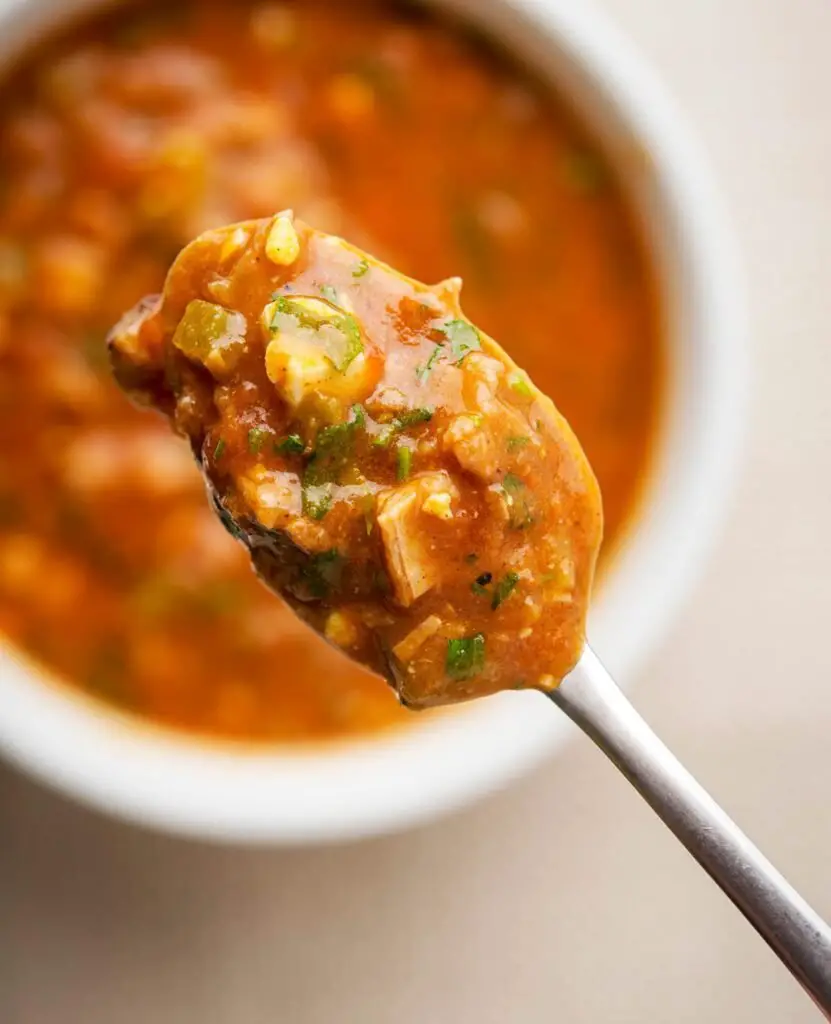
History and Background of Curiara – Venezuelan Stew with Exotic Meats
Curiara, a traditional stew from Venezuela, has deep historical roots and is associated with the indigenous communities of the Amazon rainforest. The dish is named after the traditional dugout canoe used by these communities, reflecting a close connection to the surrounding environment.
Curiara is known for featuring exotic meats like turtle, monkey, or snake, sourced from the rich biodiversity of the Amazon. Indigenous tribes have passed down this culinary tradition, emphasizing sustainable practices and respect for the environment.
While considered a cultural delicacy, it’s essential to approach the consumption of exotic meats with awareness and ethical considerations.
Venezuela Food – Ingredients for Curiara (Stew with Exotic Meats)
For the Stew Base:
- 2 lbs exotic meat (turtle, monkey, or snake), cleaned and diced
- 1 onion, chopped
- 3 cloves garlic, minced
- 2 tomatoes, chopped
- 1 bell pepper, diced
- 1 cup yuca (cassava), peeled and diced
- 1 cup plantains, peeled and sliced
- 1 cup coconut milk
- 2 tablespoons vegetable oil
- 1 teaspoon ground cumin
- 1 teaspoon dried oregano
- Salt and pepper to taste
- Water for cooking
Venezuela Food – Recipe for Curiara (Stew with Exotic Meats)
Preparing the Exotic Meat:
- Cleaning the Meat: Ensure the exotic meat is thoroughly cleaned and diced into bite-sized pieces.
- Marinating: Season the meat with ground cumin, dried oregano, salt, and pepper. Let it marinate for at least 30 minutes.
Cooking the Stew:
- Sautéing: In a large pot, heat vegetable oil over medium-high heat.
- Adding Aromatics: Sauté chopped onion and minced garlic until softened and aromatic.
- Browning the Meat: Add the marinated exotic meat to the pot, browning it on all sides.
- Incorporating Vegetables: Stir in chopped tomatoes, diced bell pepper, yuca, and sliced plantains.
- Pouring Coconut Milk: Add coconut milk to the pot, ensuring it covers the meat and vegetables.
- Simmering: Add water as needed, cover the pot, and let the stew simmer for 1.5-2 hours or until the exotic meat is tender.
Serving Information:
- Serves: 6-8 people
- Estimated Cooking Time: 2-2.5 hours (including marinating time)
- Approximate Calories (per serving): 400-500 kcal (calories may vary based on specific exotic meat and ingredient brands)
Curiara, with its unique blend of flavors and cultural significance, offers a taste of the Amazon rainforest in Venezuelan cuisine. Approach the preparation of exotic meats with mindfulness and an understanding of sustainable practices.
Venezuelan Cuisine – Arepas

Originating from the indigenous tribes of Venezuela, arepas are cornmeal patties that are grilled, baked, or fried. Traditionally served during breakfast, they are now a staple at any time of the day. Filled with a variety of ingredients like cheese, meats, or beans, they are a versatile delight.
Ingredients for Arepas:
- 2 cups of pre-cooked white cornmeal (masa harina)
- 2 ½ cups of water
- 1 teaspoon of salt
- Oil or butter for frying
How to Prepare Arepas:
Mix the cornmeal, water, and salt in a bowl until a dough forms. Let it rest for a few minutes. Shape the dough into small balls and flatten them into discs. Heat oil or butter in a pan and fry the arepas until golden brown on both sides.
To serve, split the arepas and stuff them with your choice of filling. Pair them with a refreshing glass of papelon con limon, a traditional Venezuelan lemonade.
Venezuelan Cuisine – Tequeños

Tequeños are cheese sticks wrapped in a thin dough and then fried until crispy. Often served at parties and gatherings, they are a beloved Venezuelan snack.
Ingredients for Tequeños:
- 2 cups of all-purpose flour
- 1 stick of butter
- 1 egg
- 1 teaspoon of salt
- 200g of white cheese (queso blanco), cut into sticks
- Oil for frying
How to Prepare Tequeños:
In a bowl, combine flour, butter, egg, and salt. Knead until a smooth dough forms. Roll out the dough thinly and cut into strips. Wrap each cheese stick with a strip of dough, sealing the ends. Heat oil in a deep fryer or pan and fry the tequeños until golden brown.
Serve hot with a tangy dipping sauce. A cold beer or a fruity cocktail would be the perfect accompaniment.
Venezuelan Cuisine – Pabellón Criollo

This dish is often considered the national dish of Venezuela. It consists of shredded beef, black beans, rice, and fried plantains. Pabellón Criollo represents the country’s multicultural heritage, with each component symbolizing different cultural influences.
Ingredients for Pabellón Criollo:
- 500g of beef flank steak
- 2 cups of black beans
- 2 cups of rice
- 2 ripe plantains, sliced
- 1 onion, chopped
- 2 cloves of garlic, minced
- 1 bell pepper, chopped
- 2 tomatoes, chopped
- Salt, pepper, and cumin to taste
- Oil for frying
How to Prepare Pabellón Criollo:
Boil the beef until tender and shred it. In a pan, sauté onions, garlic, bell pepper, and tomatoes. Add the shredded beef and season with salt, pepper, and cumin. In separate pots, cook the black beans and rice. Fry the plantain slices until golden brown.
Serve the beef, beans, rice, and plantains together on a plate. A glass of malta, a sweet non-alcoholic beverage, complements this dish beautifully.
Venezuelan Cuisine – Cachapas

Cachapas are sweet corn pancakes, often served with cheese or meat. They are a delightful blend of sweet and savory flavors.
Ingredients for Cachapas:
- 6 fresh corn ears
- 2 tablespoons of sugar
- 1 teaspoon of salt
- 1/2 cup of milk
- Butter for frying
How to Prepare Cachapas:
Remove the corn kernels from the ears and blend them with sugar, salt, and milk until smooth. Heat butter in a pan and pour the batter to form pancakes. Cook until golden brown on both sides.
Serve hot with cheese or shredded meat. A cold chicha, a creamy rice drink, pairs well with cachapas.
Venezuelan Cuisine – Hallacas

Hallacas are Venezuelan tamales made with a corn dough and filled with a meat stew. They are traditionally prepared during Christmas.
Ingredients for Hallacas:
- 2 cups of cornmeal
- 500g of pork, beef, and chicken, cooked and shredded
- 1 onion, chopped
- 2 bell peppers, chopped
- 2 cloves of garlic, minced
- 2 tomatoes, chopped
- 1 cup of chicken broth
- Salt, pepper, cumin, and paprika to taste
- Banana leaves for wrapping
How to Prepare Hallacas:
Prepare a stew with the meat, onions, bell peppers, garlic, and tomatoes. Season with salt, pepper, cumin, and paprika. Add chicken broth and let it simmer. Prepare a dough with cornmeal, adding water until it’s pliable. Spread the dough on banana leaves, add the stew in the center, and fold the leaves to form a parcel. Steam the hallacas for an hour.
Serve hot with a side of ensalada de gallina, a Venezuelan chicken salad. A glass of ponche crema, a creamy alcoholic beverage, is a festive choice to accompany hallacas.
Venezuelan Cuisine – Quesillo

Quesillo is a beloved dessert in Venezuelan cuisine, often compared to flan or crème caramel due to its creamy consistency and caramel topping. Its origins are believed to be influenced by Spanish settlers who brought the traditional flan recipe to the region.
time, the local ingredients and culinary techniques transformed it into the unique Venezuelan quesillo we know today. This dessert is a staple at family gatherings, birthdays, and celebrations. It’s especially popular during festive occasions like Christmas and New Year’s Eve.
The sweet and silky texture of quesillo combined with its rich caramel sauce makes it a favorite among both adults and children. Whether served at a grand event or a simple family dinner, quesillo is a testament to Venezuela’s rich culinary heritage and the joy of shared meals.
Ingredients for Quesillo:
- 1 can of condensed milk
- 1 can of evaporated milk
- 5 eggs
- 1 cup of sugar
- 1 teaspoon of vanilla extract
How to Prepare Quesillo:
Blend the condensed milk, evaporated milk, eggs, and vanilla extract until smooth. In a pan, melt the sugar until it turns into caramel. Pour the caramel into a mold and then pour the milk mixture over it. Bake in a water bath for an hour at 350°F (175°C).
Serve chilled with a drizzle of the caramel sauce. A cup of Venezuelan coffee is the perfect beverage to enjoy with quesillo.
Venezuelan Cuisine – Bienmesabe

Bienmesabe, which translates to “tastes good to me,” is a cherished dessert in Venezuelan cuisine. Its roots trace back to Spain, particularly the region of Andalusia, but the Venezuelan version has its own unique twist.
This dessert consists of layers of delicate sponge cake soaked in a rich coconut cream, often garnished with cinnamon and coconut flakes. It’s a sweet treat that marries the tropical flavors of the Caribbean with the traditional European dessert techniques.
Bienmesabe is often served at festive occasions, family gatherings, and celebrations. It holds a special place during weddings and birthdays, symbolizing sweetness and joy. Its creamy and rich texture combined with the aromatic coconut makes it an irresistible delight, and it’s a testament to the rich culinary tapestry of Venezuela.
Ingredients for Bienmesabe:
- 6 eggs, separated
- 2 cups of sugar
- 2 cups of grated coconut
- 1 cup of coconut milk
- 1 teaspoon of vanilla extract
- Sponge cake
How to Prepare Bienmesabe:
Whisk the egg yolks with sugar until creamy. Add the grated coconut, coconut milk, and vanilla extract. Cook the mixture on low heat until it thickens. Let it cool. Layer the sponge cake with the coconut cream.
Serve chilled. A glass of cocada, a Venezuelan coconut smoothie, complements this dessert beautifully.
Conclusion
Venezuelan cuisine is a testament to the country’s rich cultural and geographical diversity. From savory arepas to sweet quesillo, every dish tells a story of tradition, love, and celebration. Whether you’re a seasoned chef or a culinary novice, these recipes promise a delightful gastronomic journey through the heart of South America.
FAQ’s
What is the national dish of Venezuela?
Pabellón Criollo, a dish consisting of shredded beef, black beans, rice, and fried plantains.
Are arepas only eaten for breakfast?
No, arepas are versatile and can be eaten any time of the day.
What is the traditional drink to pair with hallacas?
Ponche crema, a creamy alcoholic beverage, is a festive choice.
Is Venezuelan coffee strong?
Yes, Venezuelan coffee is known for its robust flavor and strength.
What is the main ingredient in bienmesabe?
Coconut is the star ingredient in bienmesabe.
Are tequeños similar to cheese sticks?
Yes, tequeños are cheese sticks wrapped in dough and fried until crispy.

